Accessibility tools
Bike test: two grand tourers.
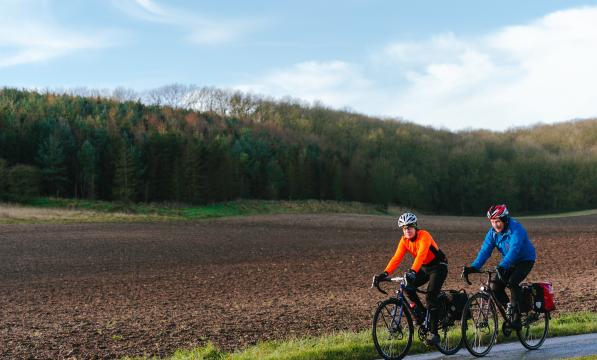
The traditional tourer fills a different role from the gravel bike, which supplanted its position in the adventure cycling spotlight. It’ll carry much more, whether camping gear or groceries; a front derailleur usually means a greater range of gears, especially lower ones; and it comes with equipment such as pannier racks and mudguards that make travel and transport cycling more convenient and cleaner.
If you don’t mind some extra heft and can live without the gravel bike’s marketing fairy dust, a tourer is just as versatile.
The price of tourers is high, since they’re not mass market bikes. On top of that, currency fluctuations caused by the uncertainty in the financial markets around the terms of the UK’s leaving of the EU and soaring shipping costs have seen all bike prices rise steeply over the last few years.
The days of the £700 Dawes Galaxy are gone – as is the bike itself, which recently ceased production. A four-figure sum is standard even for an entry-level model like Ridgeback’s Voyage. Factor in higher-tier components and equipment like a hub dynamo and you’re likely looking at closer to £2,000.
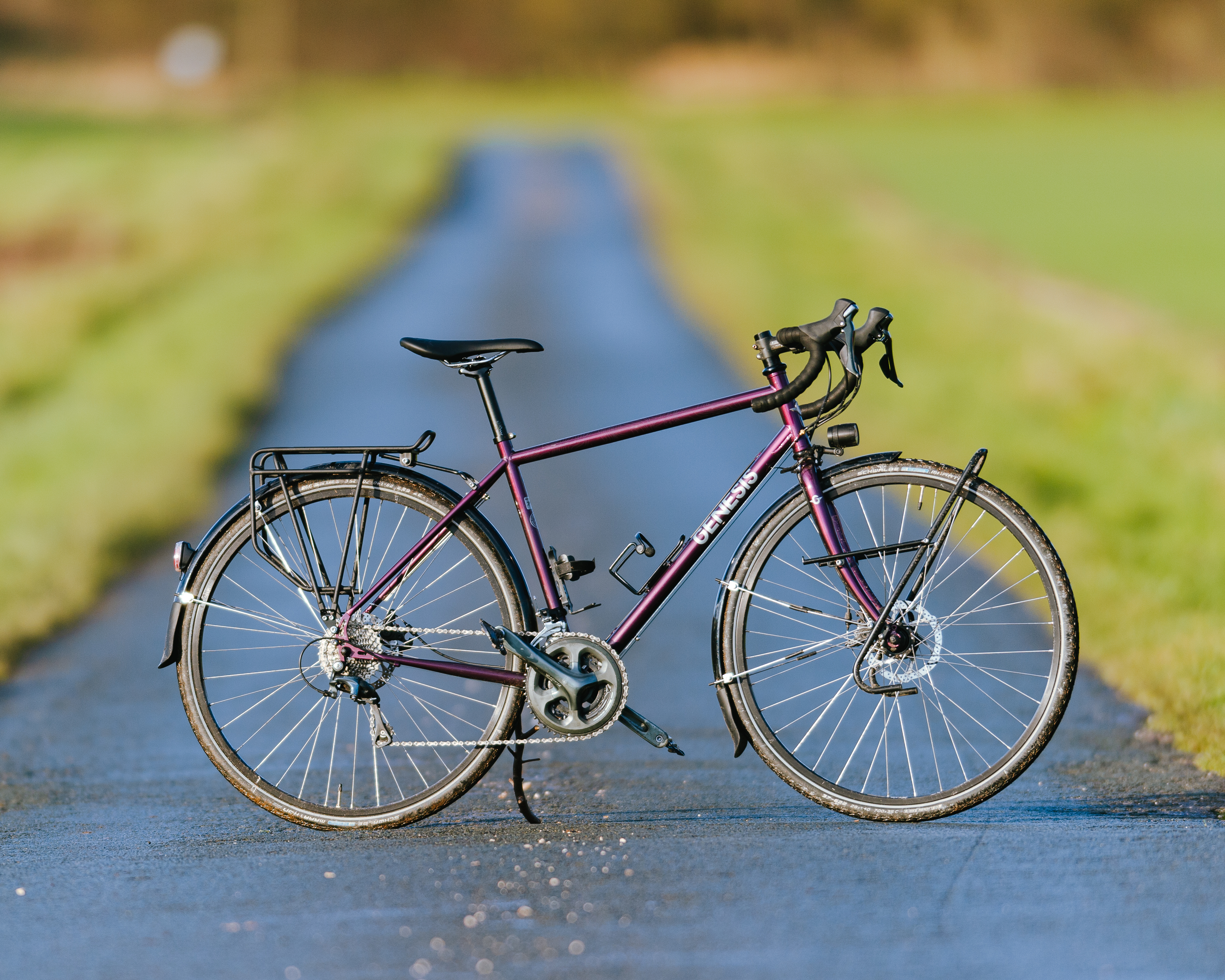
The UK-designed Genesis Tour de Fer 30 – the name is a spin off from the brand’s popular Croix de Fer – is the top model of four, two of which have drop bars, two flats. The flat-bar bikes are £250-£350 cheaper and come with more practical gearing, so it’s worth considering how attached you are to drops. Maybe it’s time to try the trekking bike approach?
Bombtrack is a German company I initially thought was American because its bike range is reminiscent of Surly’s or Salsa’s. Its Adventure & Touring lineup is on point, style-wise. For example, one of its Fargo-like Bombtrack Beyond models comes with a porteur rack…and no mudguards. In fully equipped contrast there’s also this, the Arise Tour.
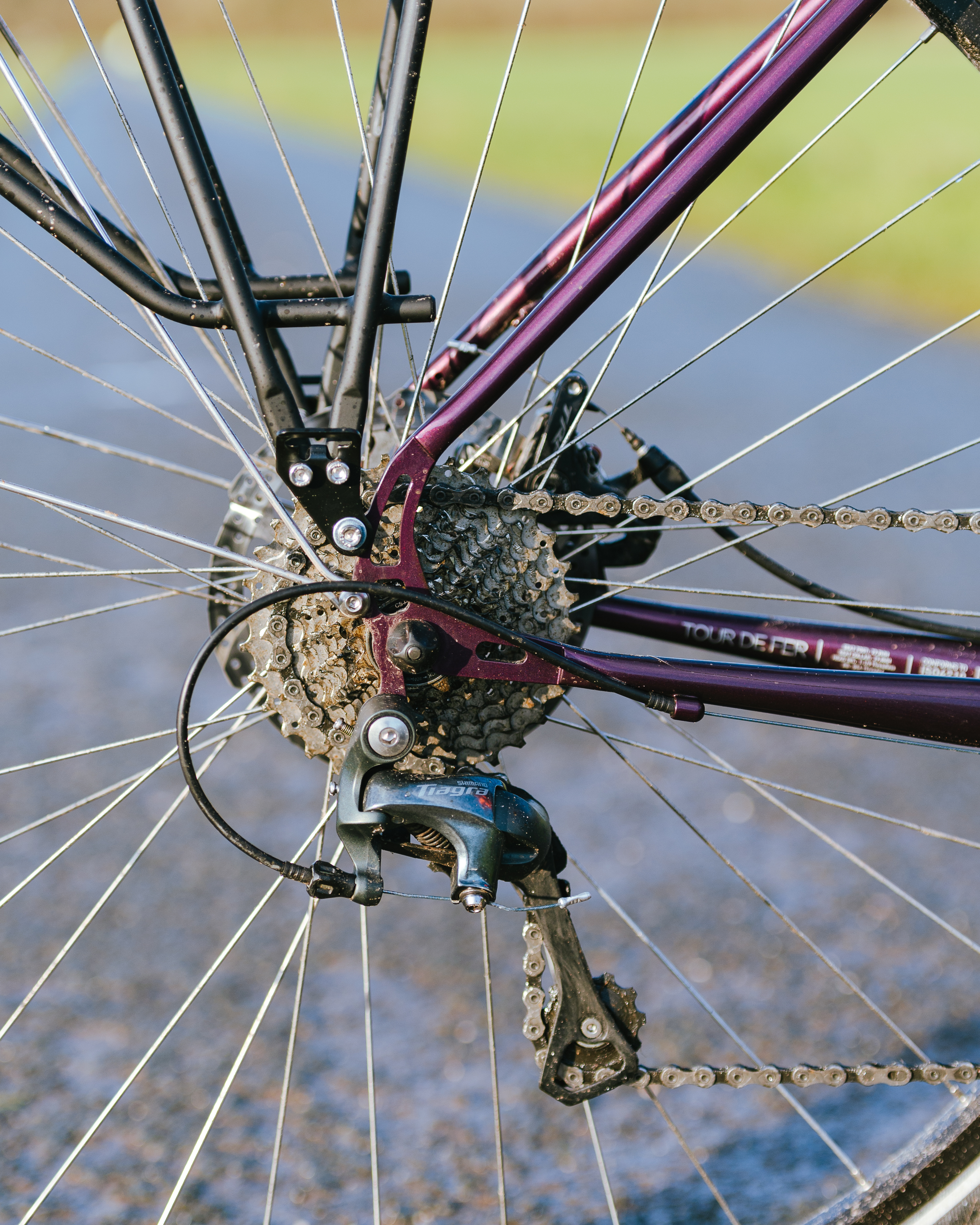

Frame and fork
Both bikes have robust chromoly steel framesets. The principal benefit over aluminium or even titanium isn’t so much that steel might be repaired by a blacksmith in Azerbaijan but, when built like this, that it’s surely less likely to break in the first place.
These are not svelte frames with steel’s famed springy ride: they’re heavy, strong and stiff. Ride comfort comes not from the frame material but from the wider tyres, ergonomic contact points and geometry.
The Genesis is unusually long for a Medium frame – the same length, in fact, as the Bombtrack in Large. I like a long frame for a tourer. It gives more toe room so you don’t kick the front mudguard to bits or catch it at the worst moment weaving up a 20% climb. And the longer wheelbase is good for stability.
With a 100mm stem, however, I could only comfortably ride it on the bar tops. So I switched in a 60mm stem (pictured) for the test. If I’d had one, 70mm would’ve been better.
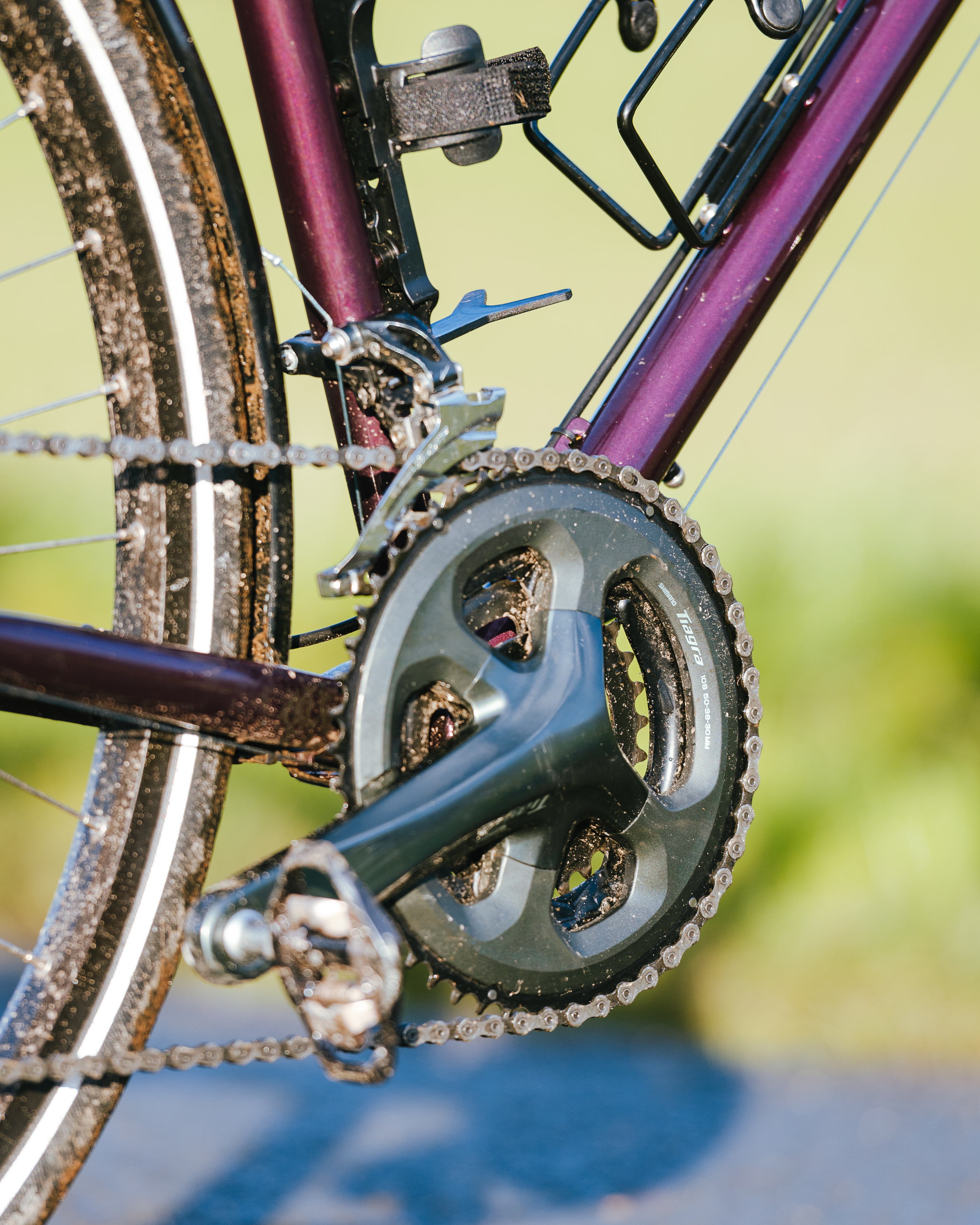
The Medium Bombtrack fitted medium-height me as supplied, since it has a shorter top tube and a slightly shorter stem. The front centres distance (centre of bottom bracket to centre of front hub) is shorter too. With a mudguard over a big tyre, there’s not much room for your toes – especially if you favour flat pedals. I frequently kicked the front mudguard during the test.
The Medium is surely the over-lappiest size since it’s the shortest frame to squeeze in big-tyred 700Cs (as well as mudguards); the Small and Extra Small have 650B wheels. If I were buying, I’d be tempted to fit a correspondingly shorter stem to the longer-framed Large.
In terms of frame details, the Bombtrack is a little different from the more traditional Genesis. Its dropouts are 12mm thru-axles, which offer more secure wheel retention and some extra stiffness at the hub – no bad thing for a heavily laden bike.
The rear dropouts aren’t named but look like Paragon Machine Works sliding ones. They’d enable you to tension the chain and continue riding if you broke the rear derailleur.
Both bikes have a full complement of frame fittings. As well as rack and mudguard mounts, each will carry three spare spokes and at least three bottles. The Bombtrack could take a fourth if you fitted a cage to the top tube mounts meant for a small ‘fuel tank’ frame bag.
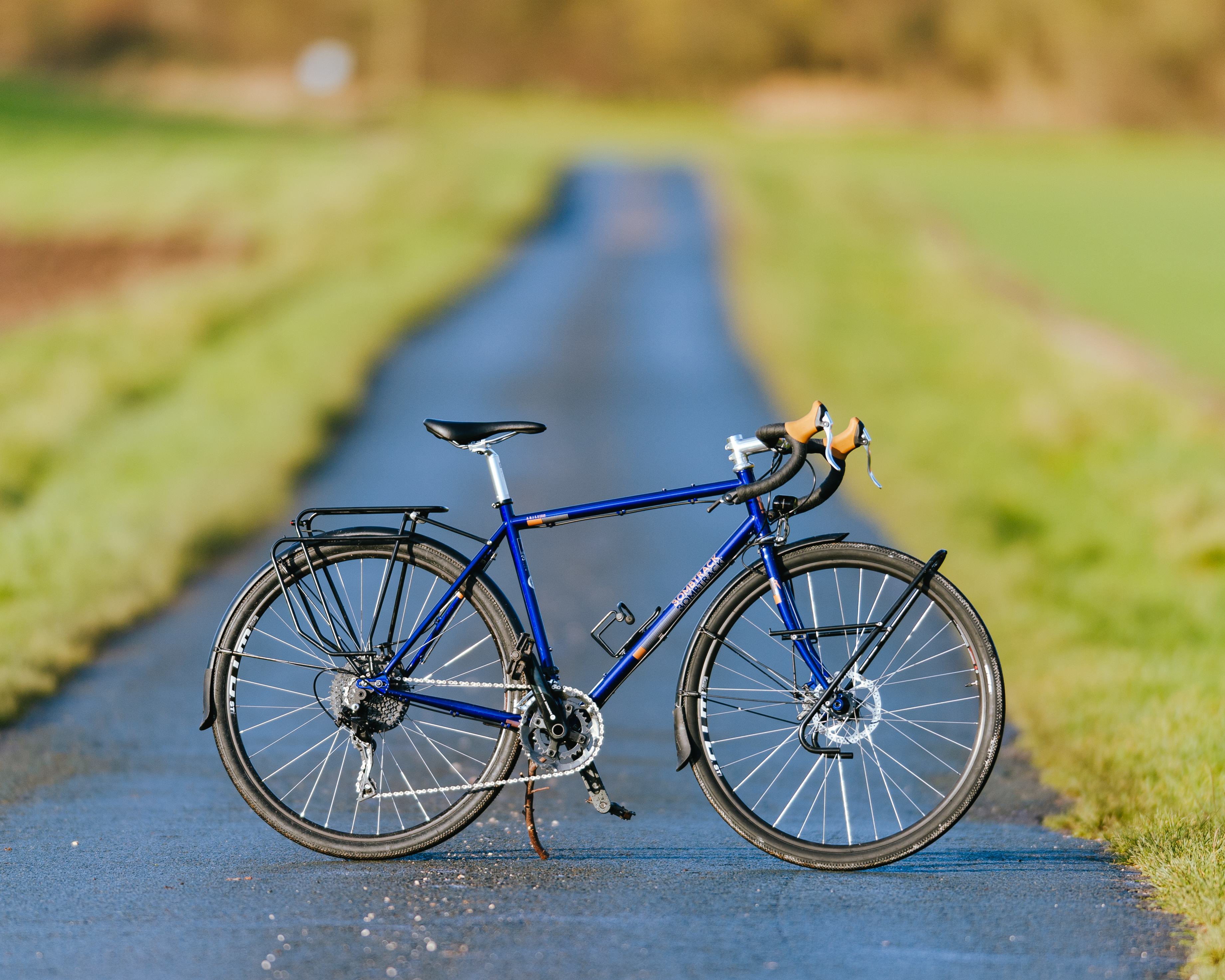
Touring bikes need strong wheels. The Genesis has them. Its 36-hole Sun Rhyno Lite rims are heavy duty hoops intended for mountain biking. They’d actually be better suited to wider, lower pressure tyres than the 37mm Marathons fitted – if only there were more clearance under the mudguards. On such wide rims, these narrower, higher pressure tyres contribute to a wooden ride feel.
The Bombtrack’s wheels have only 32 spokes. The rear has a wider axle (142mm), so will be a little stronger and stiffer due to the better bracing angle of the spokes. More spokes would nevertheless be better, especially if you’re heavier than average, ride on dirt roads or carry a camping load.
The Bombtrack’s rims are tubeless compatible, which is a two-edged sword. If, like most tourists, you don’t go tubeless, you’ll be stuck with unnecessarily tight-fitting tyres.
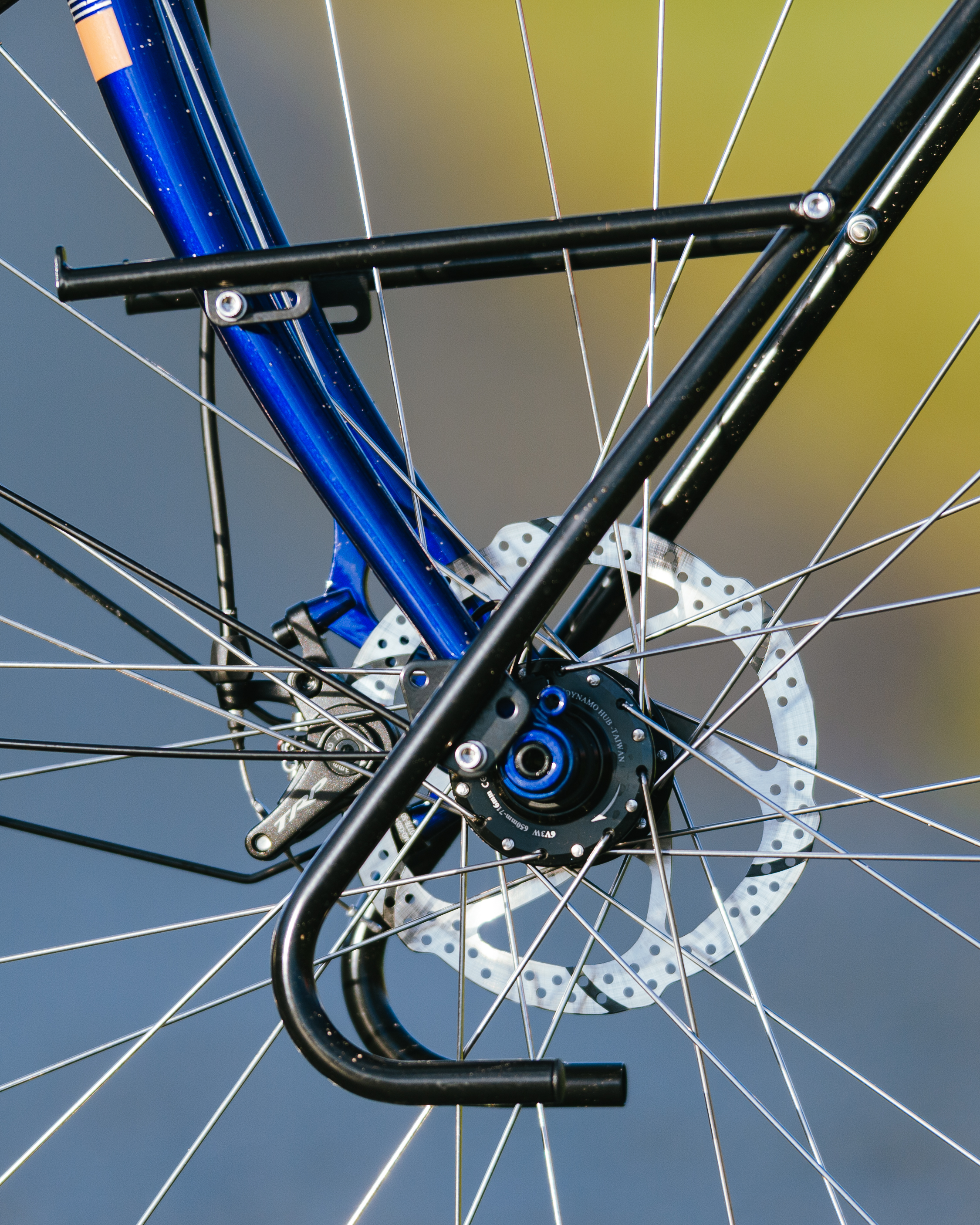
There’s no dedicated touring bike groupset so the question of what gearing to use is moot. The Genesis has a 3×10 Shimano Tiagra groupset. (Madison, the parent company of Genesis, distributes Shimano in the UK.) On the upside, that means brifters (integrated brake and shift levers) and a set of components that are meant to mesh well together – and do.
On the downside, Tiagra is a road bike groupset. A 50-39-30 triple and an 11-32 cassette would be fine on an audax bike but is a hindrance on a heavyweight load-lugger. The 26in bottom gear is way too high, as is the 126in top.
Bombtrack’s solution is better. Microshift bar-end shifters operate Microshift road front and mountain bike rear derailleurs, marrying a sub-compact double chainset to an 11-42 cassette. This gives a useful 20in bottom gear, plus simpler and more reliable front shifting.
A smaller front double, such as 40-24, would be better yet. Top gear would still be big enough at ~100in, bottom gear a wallcrawling 16in, and you'd be able stay in the big ring most of the time. Bar-ends aren’t as convenient as brifters but here the pros outweigh the cons.
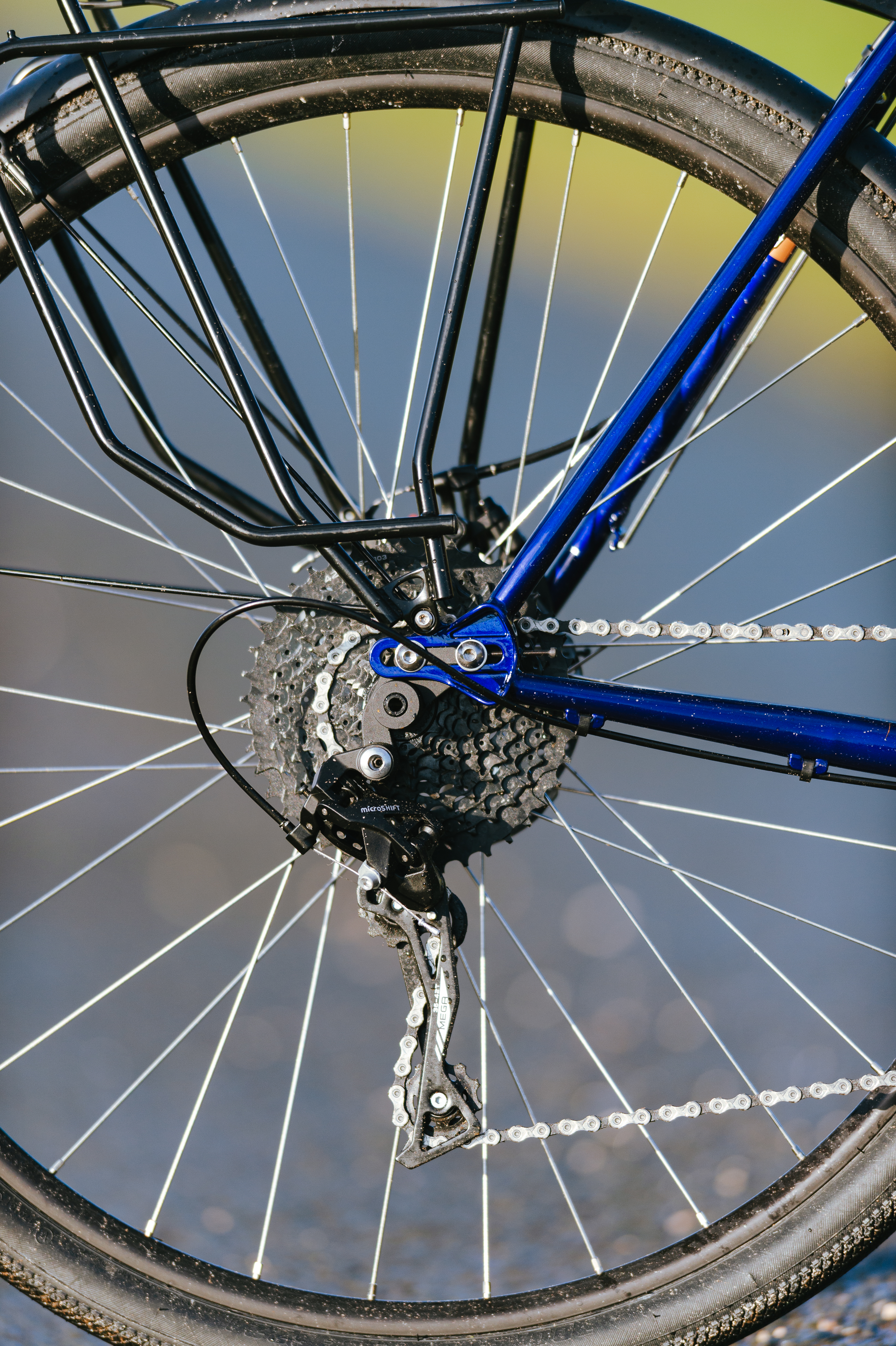
Both bikes use TRP Spyre-C mechanical discs. Braking is smooth, since both pistons move rather than just one, but coming from Avid BB7s they seemed to me a bit weedy in outright power. Curiously, the Genesis has six-bolt rotors fitted to Centerlock hubs with adapters. I guess six-bolt rotors are easier to find on tour, but why not have six-bolt hubs as well?
Hub dynamo lighting is fitted to both bikes, and it’s useful both for travel and transport. The Supernova lights of the Bombtrack are always on unless you unplug the dynamo at the hub. That makes a certain sense for an urban bike but I found it oddly annoying elsewhere.
The Busch und Müller lights of the Genesis are switchable. The rear, a mudguard-mounted Secula, incorporates a reflector and stands out more than the Bombtrack’s minimalist Supernova rear light.
At this price, you expect racks and mudguards to be good. The racks are: both of those on the Bombtrack are excellent Tubus models, as is one of the Genesis’s – and I’ve no complaints about its M Part companion.
The mudguards are less good. The Sunnywheel ones on the Genesis are a little narrow, judging by how dirty the bike became. The rattly Bombtrack Pipe guards are worse. Their plastic stay ends are fragile, a point proved by one being snapped in transit. I glued it for the photoshoot but soon kicked it apart again.
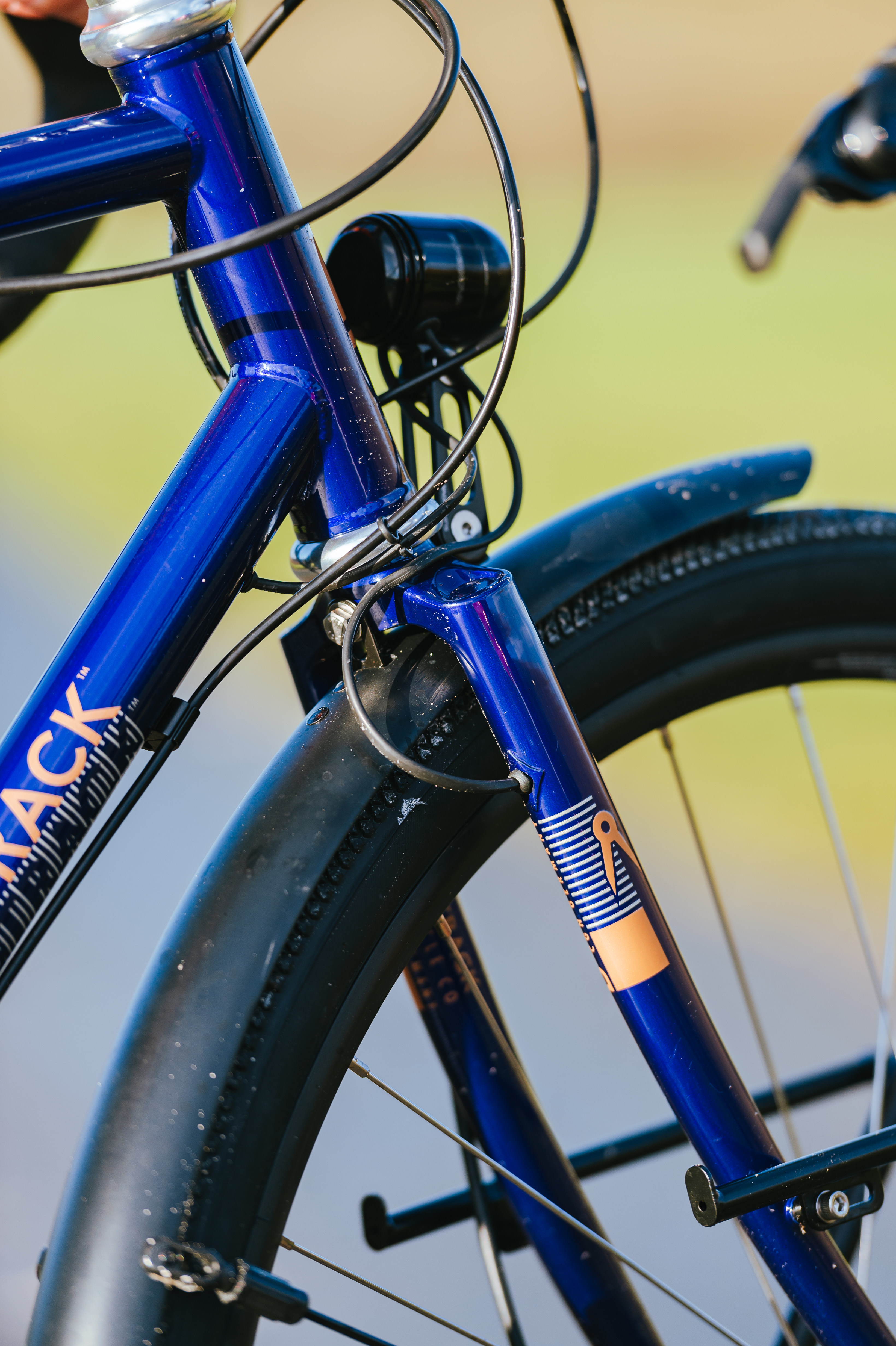
As you’d expect from touring bikes, these have stable and predictable handling. With panniers fitted, they’re both pleasingly stiff to ride in or out of the saddle; there’s no flex or shimmy. Both bikes have a slightly flared drop bar, offering more steering leverage on the drops. This could help control on dirt roads or with bigger loads, such as overstuffed panniers or a toddler in a rear child seat.
Neither bike has much pep, not because they’re heavy (although they are) but because the tyres are rather stodgy. Yes, they’re touring bikes and reliability trumps speed when travelling, but even a tourer will spend much or most of its life not actually touring. I’d fit Schwalbe Marathon Supremes, a touring tyre with excellent on-road rolling performance.
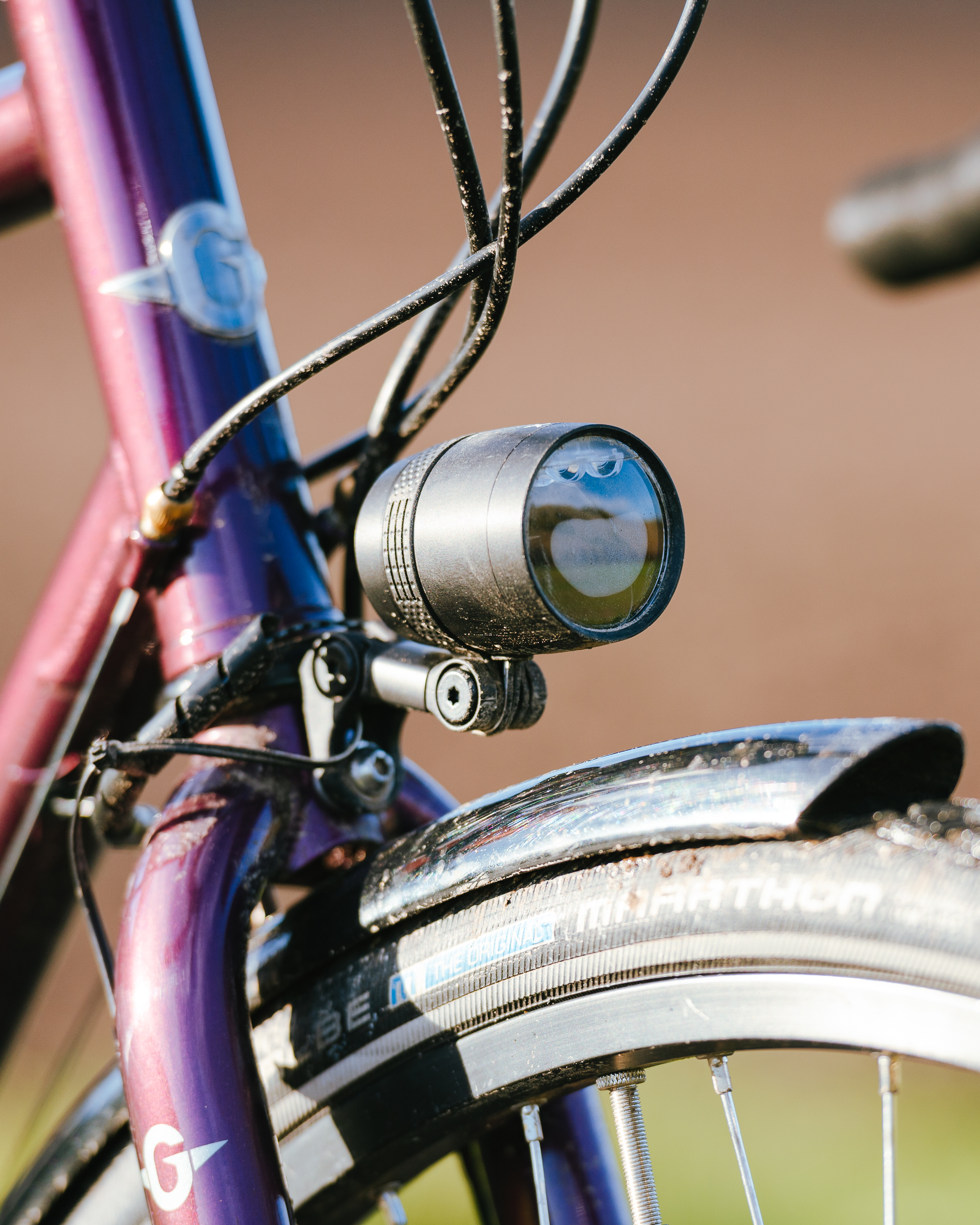
The Genesis is a durably built and well-equipped bike with a significant drawback for loaded touring: its too-high gearing. A quick fix would be to ditch the big chaining, then fit a Wolf Tooth RoadLink and an 11-40 cassette. Otherwise, aside from a shorter stem, the only thing it lacks is frame clearance for the bigger tyres its rims are ready for.
The Bombtrack is equally well built and equipped. It’s the better tourer as spec’d because its gears will scale hills you’d walk up with the Genesis. Fundamentally, a tourer is a bike for having a nice ride on – not a nice stroll with. If the chainrings were smaller, the frame 10-15mm longer, and the mudguards SKS Chromoplastics, I’d like this thoughtfully designed Bombtrack even more.
Other options
Spa cycles wayfarer £1,050+.
Keenly priced 3×9-speed disc-braked steel tourer from Spa. Custom gear ratios are an option, as is (for an extra £135) hub dynamo lighting. Similar 725 Steel Tourer is available if you don’t want discs.
Surly Disc Trucker £1,900
The Disc Trucker’s sturdy steel frame has big clearances and lots of braze-ons, while the 3×9 drivetrain has a decent (26/34) bottom gear. But with no equipment, it’s looking expensive these days.
First published in Cycle magazine, February/March 2021 issue. All information correct at time of publishing.
- Cycle magazine
Every two months Cycling UK members receive Cycle magazine, filled with interesting and informative articles, news and reviews for all cyclists.
Members can read the magazine in full online; non-members can read selected highlights.
- Read cycle magazine online
Our test promise
At Cycling UK and Cycle magazine, we are proudly independent. There’s no pressure to please advertisers as we’re funded by our members. Our product reviews aren’t press releases; they’re written by experienced cyclists after thorough testing.
Genesis Tour De Fer 30
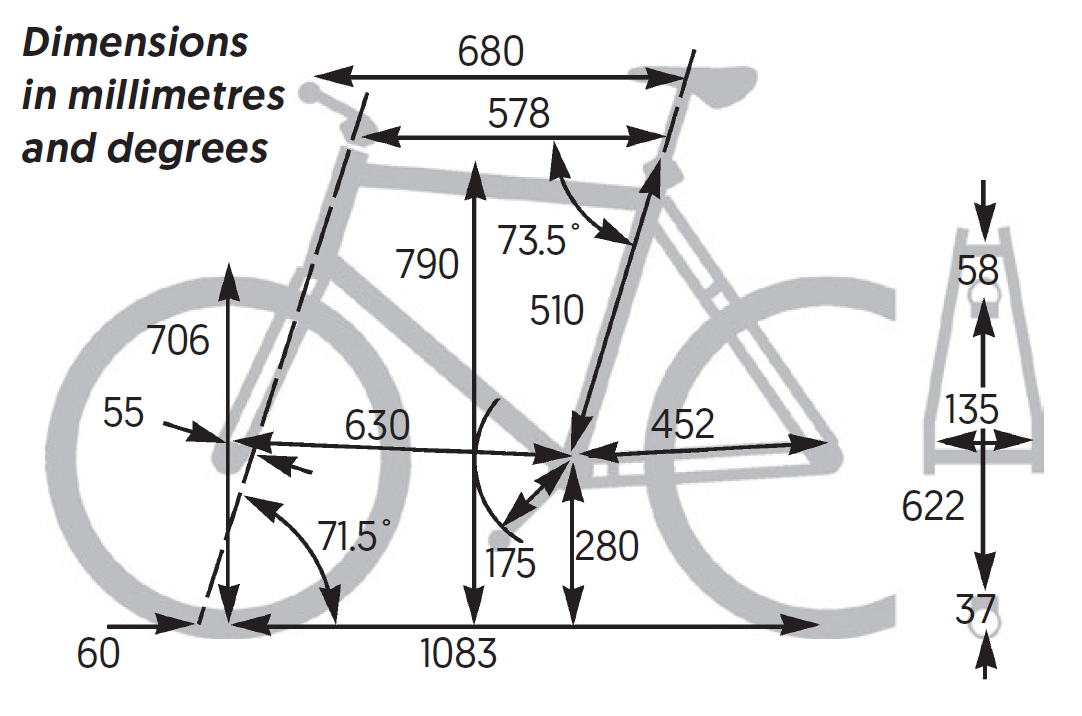
Price: £1,999.99
Sizes: XS, S, M (tested), L, XL
Weight: 15.26kg/33.57lb (no pedals)
Frame & fork: Reynolds 725 chromoly steel frame with fittings for rear rack, mudguard, 3 bottles, 3 spokes. Chromoly steel fork with fittings for low-rider rack and mudguard
Wheels: 37-622 Schwalbe Marathon tyres, 622×27 Sun Ringle Rhyno Lite rims, 36×3 steel spokes, Shimano DH-UR700-3D dynamo front hub, Shimano Deore FHM6000 rear hub
Transmission: 175mm Shimano Tiagra chainset with 50-39-30 chainrings, Shimano BB-RS300 bottom bracket, KMC X10 chain, Shimano CS-HG500 10-speed 11-32 cassette. Shimano Tiagra 4700 shifters and derailleurs. 30 ratios, 26-126in
Braking: Shimano Tiagra levers, TRP Spyre-C mechanical discs, 160mm rotors with 6-bolt-to-Centerlock adapters
Steering & seating: 420×31.8mm Genesis flared drop bar, 100mm×6º Genesis stem, threadless headset. Genesis saddle, 27.2×350mm Genesis seatpost
Equipment: M Part Summit rear rack, Tubus Tara front rack, Sunnywheel mudguards, B&M IQ-8 front lamp, B&M Secula rear lamp, 3 bottle cages (inc one Monkii cage)
Bombtrack Arise Tour
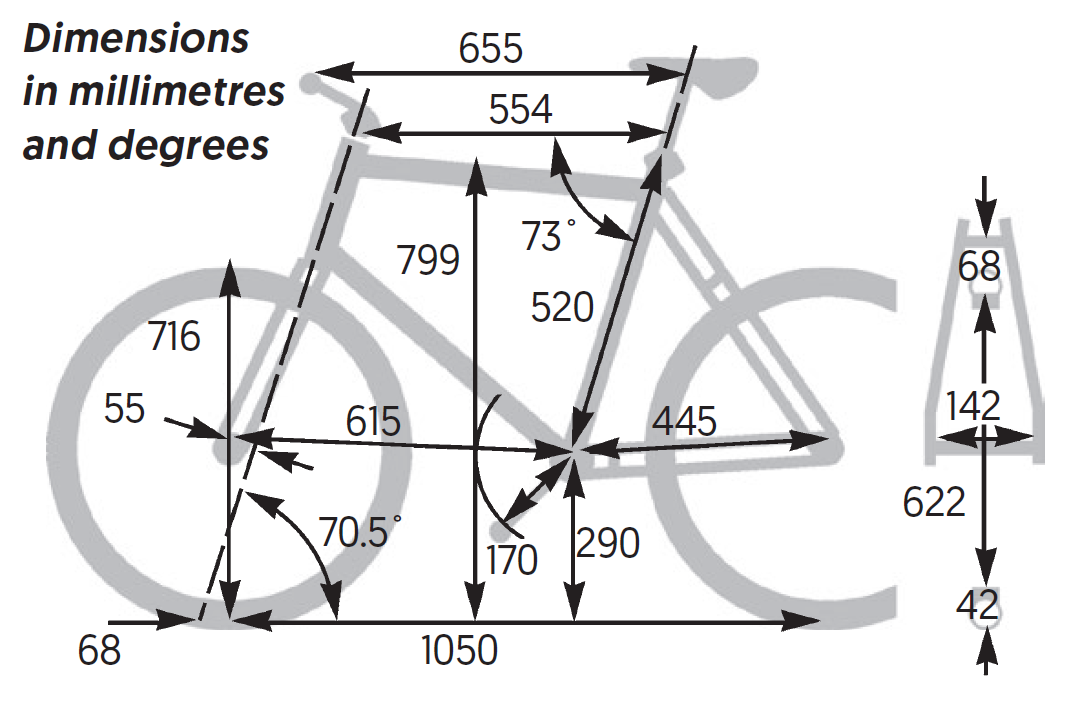
Price: £1,950, frameset £660
Weight: 14.47kg/31.83lb (no pedals)
Frame & fork: Double-butted chromoly steel frame, thru-axle sliding dropouts, fittings for rear rack, mudguard, 4 bottles, 3 spokes. Chromoly thru-axle fork, fittings for low-rider rack, mudguard
Wheels: 40-622 Vee Tire Speedster tyres, 622×19 WTB ST i19 TCS rims, 32×3 spokes, 100×12mm KT dynamo front hub, 142×12mm Bombtrack Arc rear
Transmission: 170mm Bombtrack Ames chainset with 46-30 chainrings, external BB, KMC X10 chain, Microshift CSH103 10-speed 11-42 cassette. Microshift BS-M10 shifters, Microshift Centos FD-R552-B front derailleur, Microshift XLE RD-M62L rear. 20 ratios, 20-118in
Braking: Tektro RL-340 levers, TRP Spyre-C mechanical discs, 160mm rotors
Steering & seating: 440×31.8mm Bombtrack CX-10 bar, 90mm×7º stem, threadless headset. Bombtrack saddle, 27.2×300mm Bombtrack seatpost
Equipment: Tubus Logo rear & Tara front racks, Supernova E3 Pure 3 front and E3 Tail Light 2 rear lamps, Bombtrack Pipe mudguards
Popular content
- Journey planner
- Join Cycling UK today
- A guide to cycle tyre sizes
- Does the government really know how to make e-bikes more popular?
Further reading
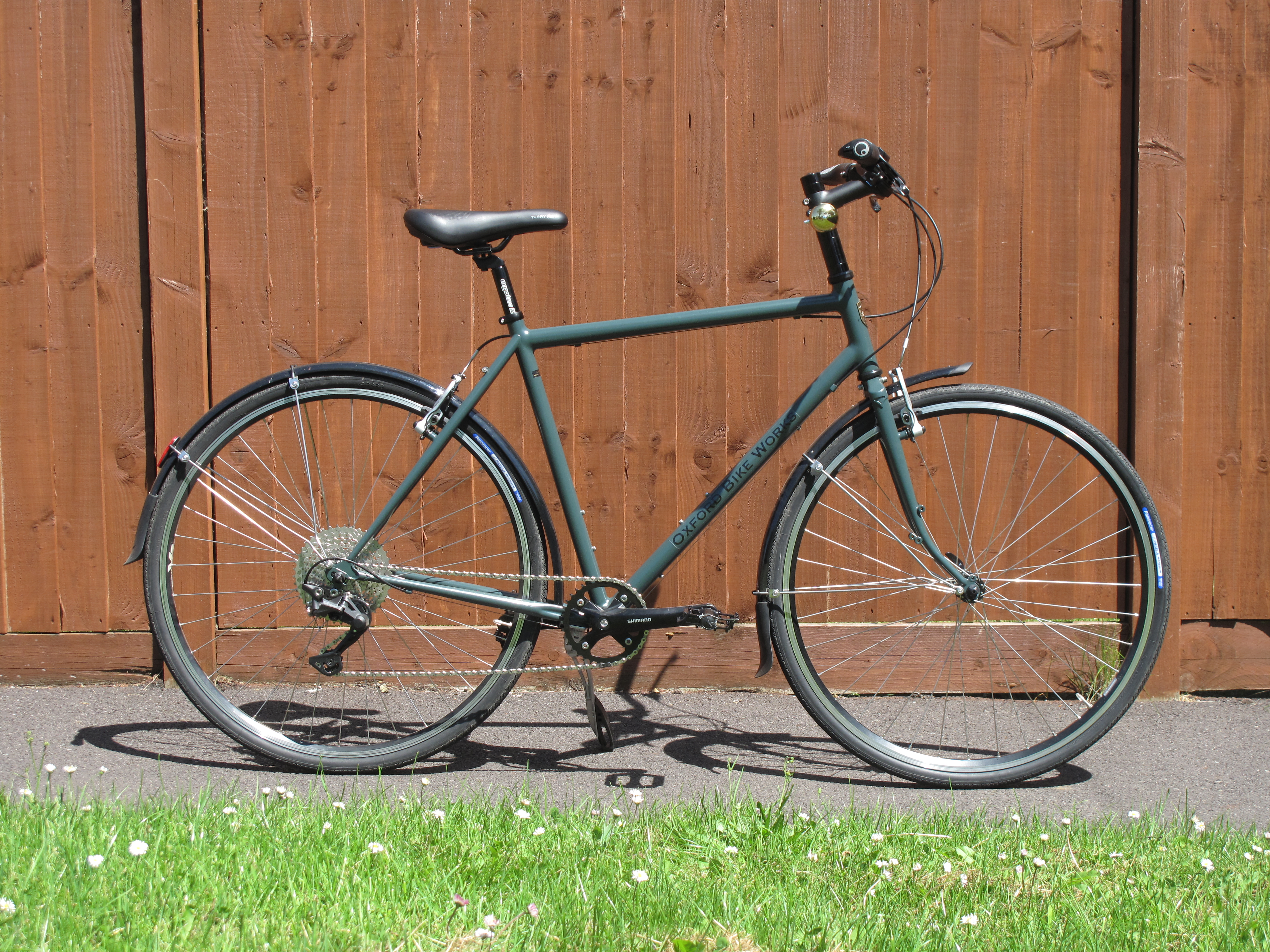
- Planning your route
- Traws Eryri
- Rebellion Way
- West Kernow Way
- Great North Trail
- King Alfred’s Way
- North Downs Way
- Donate to new routes
- Beginner advice
- Cycling as a family
- Different types of cycling
- Bikes, cycles and kit
- Seasonal advice
- Safety advice
- Maintenance advice
- Ride together (clubs and groups)
- Our campaigns
- Take action to support cycling
- Cycle Advocacy Network
- Cyclists' Defence Fund
- Sign up for updates
- Cycling UK statistics
- Cycling UK views and briefings
- General election 2024
- Become a member
- Give a gift membership
- Become a life member
- Ways of giving
- Join the conversation
- Incident Line
- Support for workplaces
- Cycle Friendly Employer
- Employer membership
- Corporate partnerships
- Organising events
- Cycling UK shop
- Support for clubs and groups
- Our projects
- Making cycling e-asier
- The Inclusive Cycling Experience
- Cycling UK in England
- Cycling UK in Northern Ireland
- Cycling UK in Scotland
- Cycling UK in Wales
- News, blogs and features
- Accessibility
Genesis Croix de Fer review
- Sign up to our newsletter Newsletter
You can trust Cycling Weekly. Our team of experts put in hard miles testing cycling tech and will always share honest, unbiased advice to help you choose. Find out more about how we test.
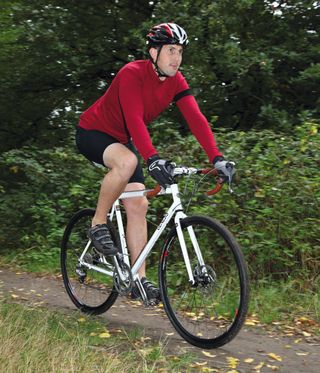
12th November 2010 Words: Derri Dunn Photos: Chris Catchpole
Cyclo-cross bikes might share plenty of characteristics with mountain bikes, but cross racing has been slow to adopt disc brakes, mostly because the sport’s governing body, the UCI, has banned them from its events — until now. As of this season, disc brakes are fair game on crossers.
However, in this respect, the quirky Croix de Fer is ahead of the game, as it has sported disc brakes since its first incarnation three years ago. Clearly, then, although the Croix de Fer can now legitimately attend cross races at the higher level, it has been designated from the start as more of a cross category rather than a pure cross racing bike.
There’s a classy pun hidden in the bike’s name — ‘Croix de Fer’ translates as ‘iron cross’ — and this Reynolds steel beauty is certainly a classy looking bike. Disc brakes, drop bars and knobbly tyres may be an avant garde combination, but this is no Frankenstein’s monster. The handsome matt white frame and honey leather style saddle and grips ooze cool.
Our main complaint, though is that for such an expensive bike, the finishing details left a bit to be desired. The ‘leatherette’ bar tape and saddle weren’t particularly expensive or hardwearing-looking up close and while we have no complaints about the workmanship on the frame, the cable guides had mini zip-ties securing the cables — they don’t look great, they’ll trap mud and there’s plenty of potential for things to work loose and rattle annoyingly.
Looks aside, though, the Croix de Fer is a pretty exciting prospect to get out onto the road — and off it. The Reynolds 725 frame and fork soaked up the bumps of tarmac and trail beautifully. We’d be happy enough to spend long days in the saddle on this one, and with its full complement of rack and mudguard eyes, it would make an eye-catching, fast and practical touring machine.
Yes, that’s right, fast. It’s the heaviest bike on test and it’s never going to keep up with the Specialized Crux on-road, but it thrums along nicely, particularly once you’re up to speed, and the frame’s so springy and compliant that this bike makes it about the journey, not the destination.
As for those disc brakes, while they’re miles more reliable than canti brakes, especially when the going gets soggy and muddy, they didn’t quite deliver the razor-sharp stopping performance we expected. They’re cable rather than hydraulic, so they can be married to the Tiagra STI shifters, but perhaps the pairing of these stoppers and levers was part of the issue.
We do feel, however, that we need to put the Croix de Fer under extra scrutiny for one massive reason: the £1,100 pricetag (although a few 2010 bikes are still knocking about for circa £900). It’s £100 over the premium-feeling Specialized and in a different galaxy to the bargain Kona; crucially it’s also £100 over the magic Cycle to Work budget which will put it out of reach for a huge segment of potential customers — after all, it would make a fabulous commuter.
The Shimano Tiagra and 105 gear spec is good, but there’s nothing quite special enough to command quite such a lofty budget that we can see. Nevertheless, it’s the whole package that makes the bike special — yes, it’s a lot of money for one bike, but more than either of the other two, it’s really more like owning many bikes.
group test: Cross Purposes introduction Kona Jake
Specialized Crux Elite Genesis Croix de Fer
group test: Cross Purposes verdict
This article first appeared in the November 2010 issue of Cycling Active magazine
Thank you for reading 20 articles this month* Join now for unlimited access
Enjoy your first month for just £1 / $1 / €1
*Read 5 free articles per month without a subscription
Join now for unlimited access
Try first month for just £1 / $1 / €1
Get The Leadout Newsletter
The latest race content, interviews, features, reviews and expert buying guides, direct to your inbox!

The UAE Team Emirates rider takes his sixth Monument victory at La Doyenne
By Joseph Lycett Published 21 April 24
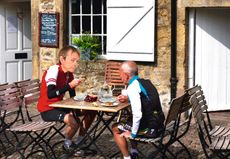
'I suspect that you can divide cyclists into personality types around coffee', muses columnist Dr Hutch
By Michael Hutchinson Published 21 April 24

State Bicycle Co. announced today a Bob Marley collaboration that features Marley-themed bikes, frame bags, top caps and apparel.
By Kristin Jenny Published 20 April 24
Useful links
- Tour de France
- Giro d'Italia
- Vuelta a España
Buyer's Guides
- Best road bikes
- Best gravel bikes
- Best smart turbo trainers
- Best cycling computers
- Editor's Choice
- Bike Reviews
- Component Reviews
- Clothing Reviews
- Contact Future's experts
- Terms and conditions
- Privacy policy
- Cookies policy
- Advertise with us
Cycling Weekly is part of Future plc, an international media group and leading digital publisher. Visit our corporate site . © Future Publishing Limited Quay House, The Ambury, Bath BA1 1UA. All rights reserved. England and Wales company registration number 2008885.

No products
Product successfully added to your shopping cart
There are 0 items in your cart. there is 1 item in your cart., genesis tour de fer 20 & 30 review, for explorers on two wheels.
When the lure of adventure becomes overwhelming, Genesis Tour de Fer is the bike to take you on a long journey. This 700C tourer , thanks to its front and rear racks, the SP dynamo hub and B&M lights, is a reliable adventure machine. Its loading capacity is guaranteed by expedition grade Tubus racks and the sturdy 725 Reynolds frameset is great value for money. So, if your intended purpose is to cross lots of countries, Genesis Tour de Fer can be your long-distance touring bike .
The long wheelbase improves stability, while the handling with loads at the front is taken care of by the well-designed combination of trail fork and stack height, which makes for a comfy-upright position.
Who prefers the flat bars for touring will go for TdF 20 , whereas the TdF 30 offers drop bars for multiple hand positions during all-day long rides.
Shimano groupset and mechanical disc brakes are chosen for long term reliability and easy repairs.
The 3x10 groupset, instead of looking aged, will be much appreciated riding loads on steep hills.
@Lifeintravel Veronica Rizzoli – tireless world explorer on two wheels - has chosen the 2018 Tour de Fer 20 for her next world tours. Here are the features she deemed ultimate in her travel bike (and the TdF has them all):
- strong steel frame , not only shock-absorbing and shock-resistant, but also easy to weld even in the middle of nowhere;
- dynamo hub, that she will also use to recharge electronic devices with USB chargers ;
- upright riding position , suitable for long days in the saddle;
- wide ratio gearing ;
- a package ready to travel just out of the box (racks, fenders, lighting, 3x bottle mounts)
You can find Veronica’s review of TdF 20 on the lifeintrave.it website. Most of the shots used in this page are Veronica’s (with permission) and many others you will find on Lifeintravel social pages.
So, if you want to move from A to B on your own in total freedom, Genesis TdF is a good opportunity to achieve your goal.
With the fenders in place, the tyres are 700x35mm, but the frame can accomodate 700x38mm without. This is also highly valuable when you are riding rough terrains. Don’t go too wide, because in the mud things might get tough.
TOUR DE FER 20 & 30: HIGHLIGHTS (at least some of them) in our opinion
- 725 REYNOLDS STEEL : it is a classic seamless crmo but heat-treated boosting tensile strength so that thinner walls can be used, achieving a lighter frame weight without compromising strength. Heated to around 1600F, the steels’ crystal lattice gets a more uniform and stronger orientation. Cooling rapidly, it maintains the structural change.
- SHUTTER PRECISION PD-8 HUB DYNAMO : With its only 410 grams, this is one of the lightest hubs in its category. It achieves the very good efficiency of 78% at 15km/h and a low no-load loss. The nominal power amounts to 3 Watt with voltage of 6 volt.
- TUBUS CARGO REAR / TARA FRONT RACKS : Tubus carriers are hand made. Over the last 18 years Tubus has developed and improved the fabrication process making thin steel tubes into highly resistant and strong bicycle racks. No compromise products mean a 30 years guarantee offered with confidence. Tubus carriers go through complex testing procedures before they are released for quality production.
- SCHWALBE MARATHON MONDIAL TYRES : Several long distance bicycle tourers agree that the Scwalbe Marathon Mondial tyres are the best all-rounder on the market, long lasting, fast on tarmac (no need for slicker tyres), good grip on rough roads and eccellent in the wet.
Whether you are circumnavigating the globe or you are a daily commuter, the Genesis Tour de Fer is well worth a look. Also available as framest only , you’ll be able to get one HERE .
Necessary cookies help make a website usable by enabling basic functions like page navigation and access to secure areas of the website. The website cannot function properly without these cookies
Preferences
Preference cookies enable a website to remember information that changes the way the website behaves or looks, like your preferred language or the region that you are in.
Statistic cookies help website owners to understand how visitors interact with websites by collecting and reporting information anonymously.
- off.road.cc
- Dealclincher
- Fantasy Cycling
Support road.cc
Like this site? Help us to make it better.
- Sportive and endurance bikes
- Gravel and adventure bikes
- Urban and hybrid bikes
- Touring bikes
- Cyclocross bikes
- Electric bikes
- Folding bikes
- Fixed & singlespeed bikes
- Children's bikes
- Time trial bikes
- Accessories - misc
- Computer mounts
- Bike bags & cases
- Bottle cages
- Child seats
- Lights - front
- Lights - rear
- Lights - sets
- Pumps & CO2 inflators
- Puncture kits
- Reflectives
- Smart watches
- Stands and racks
- Arm & leg warmers
- Base layers
- Gloves - full finger
- Gloves - mitts
- Jerseys - casual
- Jerseys - long sleeve
- Jerseys - short sleeve
- Shorts & 3/4s
- Tights & longs
- Bar tape & grips
- Bottom brackets
- Brake & gear cables
- Brake & STI levers
- Brake pads & spares
- Cassettes & freewheels
- Chainsets & chainrings
- Derailleurs - front
- Derailleurs - rear
- Gear levers & shifters
- Handlebars & extensions
- Inner tubes
- Quick releases & skewers
- Energy & recovery bars
- Energy & recovery drinks
- Energy & recovery gels
- Heart rate monitors
- Hydration products
- Hydration systems
- Indoor trainers
- Power measurement
- Skincare & embrocation
- Training - misc
- Cleaning products
- Lubrication
- Tools - multitools
- Tools - Portable
- Tools - workshop
- Books, Maps & DVDs
- Camping and outdoor equipment
- Gifts & misc

The handling is predictable, never throwing up any surprises, and remains consistent whether riding loaded or not. I've ridden faster and more exciting bikes, but the Tour de Fer isn't designed to be either of those: it's a solid package that will roll you anywhere; a stately steamer with neutral handling – unashamedly average, if you like, though that sounds a little derogatory. It's not meant to be: for a bike like this that's what you want.
That neutral handling is present both loaded and unloaded. Ride it unloaded and you can do so in a leisurely fashion. Load it up with luggage and it maintains its composure and stability very obediently.

More than that, though, as often seems to be the case with touring bikes it seems to ride better with luggage. Having it loaded up seems to leave the bike feeling a little more planted around corners and creates, possibly because of the added weight, what I would describe as a little more "spring" in the tubing.
Unloaded, that neutral handling can feel a little meandering and vague, which isn't great for quick descents or tight corners where accurate handling is a must. That changes with luggage, where the bike feels much more capable of carving around corners, although the limiting factor is undoubtedly the tyres, which, while durable, are not particularly grippy.

This, too, has to be looked at in context. The Tour de Fer 10 isn't designed to be a high-performance racer; it favours a calm ride with handling that is forgiving of mistakes. What might, elsewhere, be described as slow and unresponsive, in this case allows you to (metaphorically) sit back and enjoy the ride.
On descents you'll want to take it easy anyway, with the brakes a little lacking in power. That means you'll have to judge your stopping distances carefully and take care not to come into corners too fast.
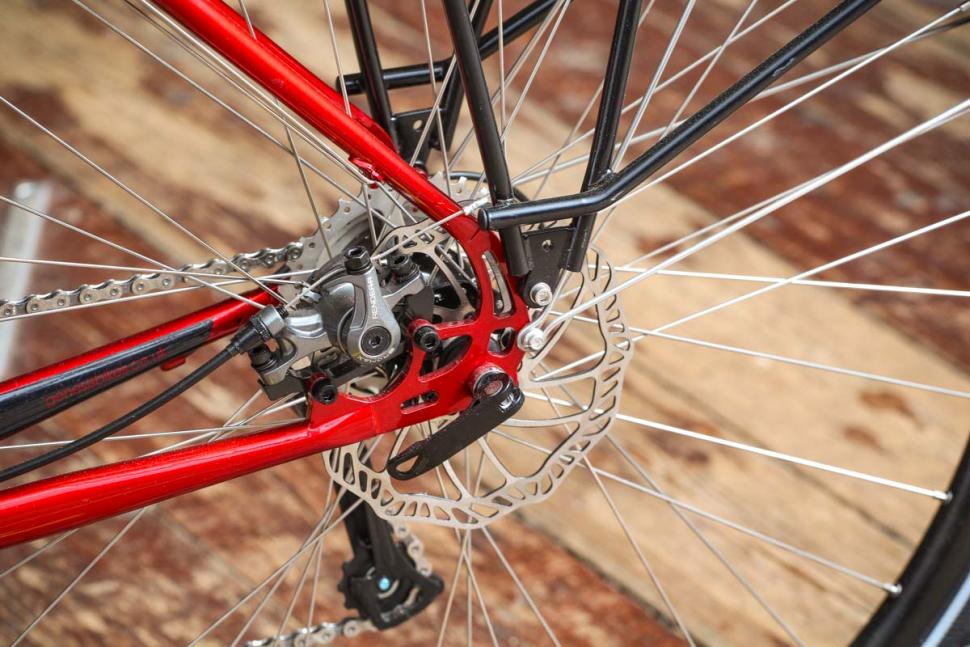
Again, though, for the riding this bike is designed for that's not likely to be a problem. You're unlikely to be winning competitions on the Tour de Fer; it's for cruising along, and it does that well. It's a refreshingly down to earth bike you can ride without too much thought.
Frame and equipment
The steel frame is Genesis' own Mjölnir double butted 4130, which provides a comfortable ride. I was actually surprised at how cosseted my rear end felt.
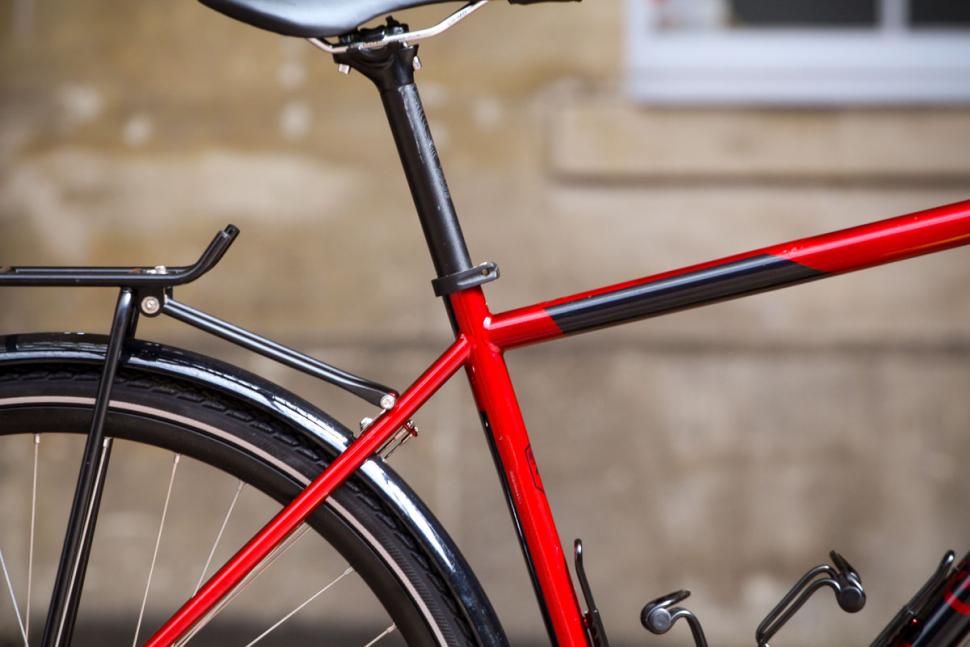
The design of the frame is elevated by details like the embossed iron cross on the top tube, and the pump peg on the head tube to allow a frame pump to be fitted easily. I've always liked the brass cable adjusters Genesis uses, too.

Schwalbe Marathon tyres almost have cult status as THE touring tyre, but I wouldn't say they are the most confidence-inspiring in terms of grip. They compensate nicely with durability and puncture resistance, though. My preference would be for something with a slicker tread for better rolling performance on the road, as well as something a little grippier. That's exacerbated in the wet, where the tyres end up feeling very greasy and leave you having to roll along tentatively.
Having the pronounced tread featured here seems superfluous, providing very little tangible benefit for the riding this bike might encounter.
> What width tyres are best for you?
The 35mm volume of the tyres isn't the largest, and it would be nice to have a bit more cushioning to further improve the bike's versatility. Obviously, with mudguards fitted there's always going to be a little less space but there are plenty of bikes out there able to fit large rubber and mudguards.
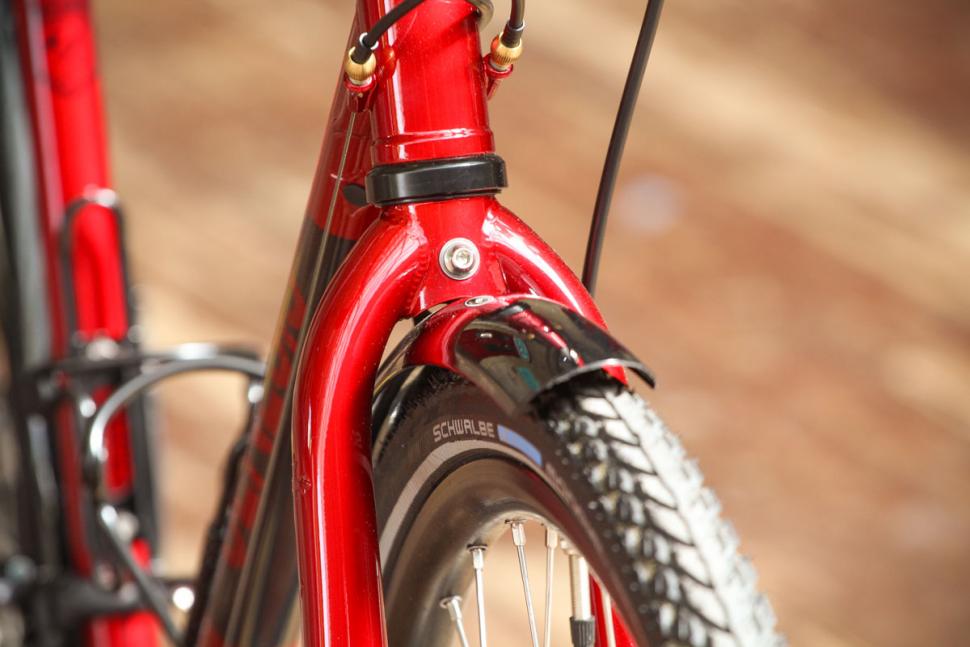
While the Shimano Sora drivetrain is undoubtedly budget fare, it still provides reliable shifting. It's quite gratifying returning to lower-end components and realising how well they actually work. Yes, they may not have the refinement and desirability of higher-end groupsets but they still work very, very well.

The triple chainset may seem a little quaint nowadays, but its 50/39/30-tooth rings paired with an 11-32t cassette provide the extra range you need when loaded up. It provides enough flexibility to grind your way up the steepest of hills and avoid spinning out when you cruise your way down again.
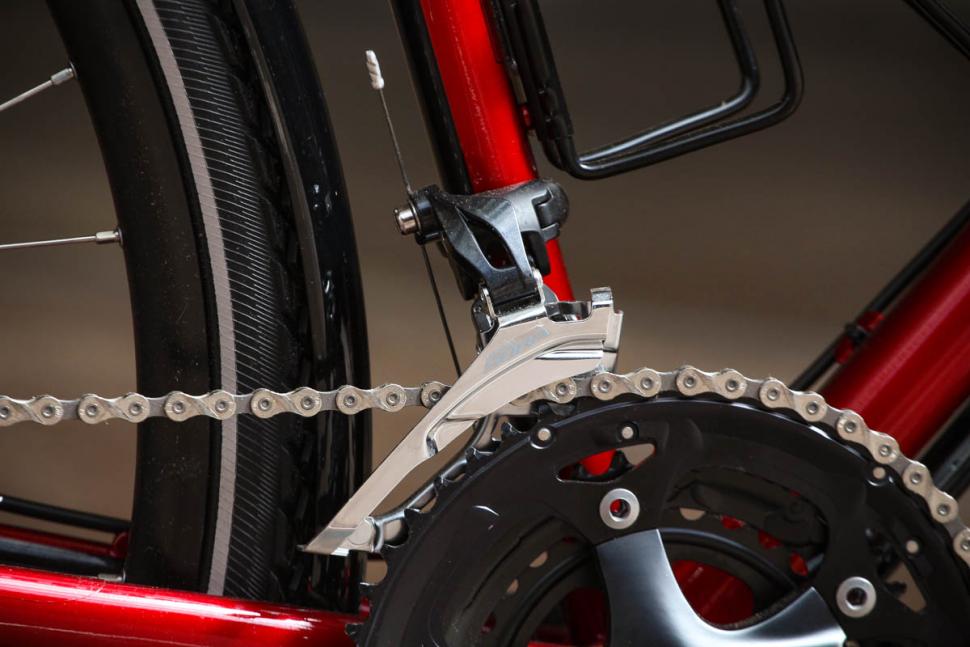
The Promax mechanical disc brakes leave a lot to be desired. Sadly, that's just a feature inherent to mechanical disc brakes generally. It does, as I said earlier, mean you'll have to take it easy (and even more so when loaded up) and be aware of your stopping distances.
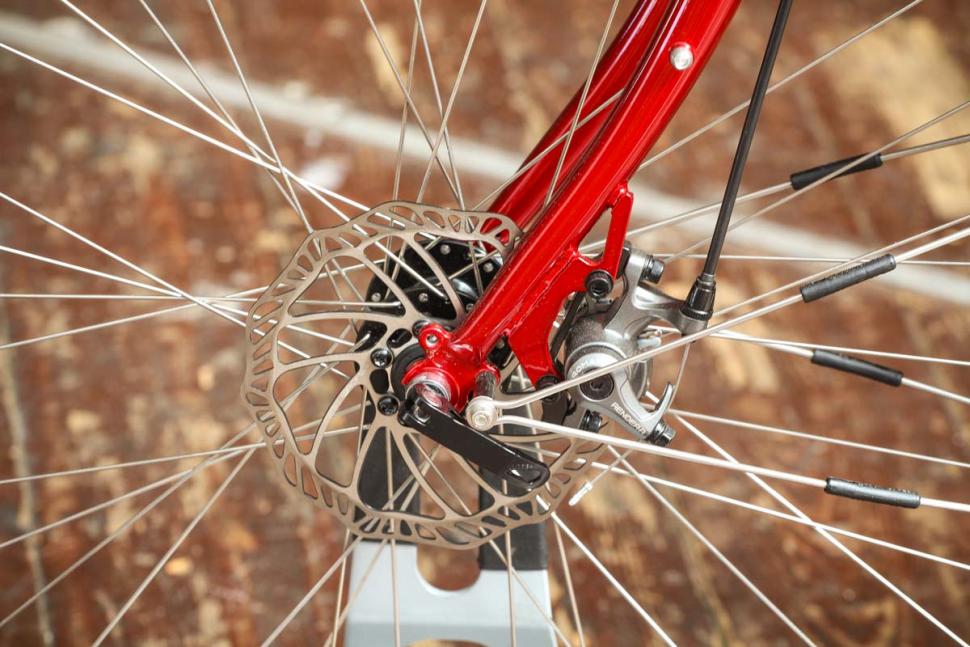
Hydraulic brakes are out of the question at this price point, but I can't help feeling that budget rim brakes would likely outperform these so-called stoppers. That's the only real sticking point on a bike that is otherwise so well equipped.
You even get a full complement of mudguards that turn this into a full-on utility machine. For anything that is going to be vaguely useful in anything other than the best weather, they are indispensable.
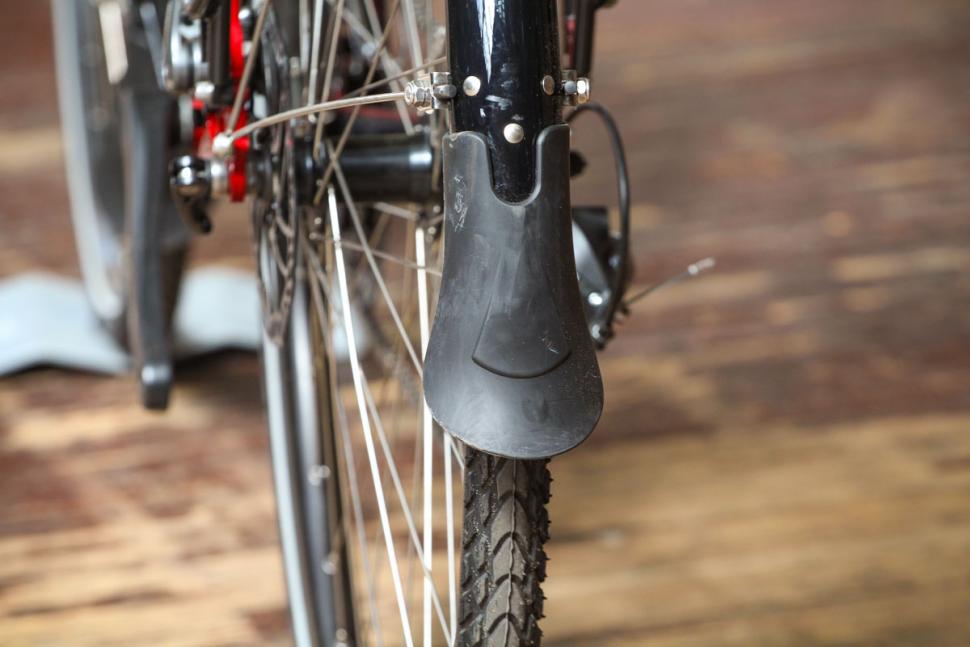
In fact this bike comes 'touring/adventure ready', with three bottle cages and a rear rack mounted from the factory. It's a pity not to have a front rack too (I prefer loading up bikes at the front as I feel it leads to better weight distribution), but the one fitted is a quality Tubus item.
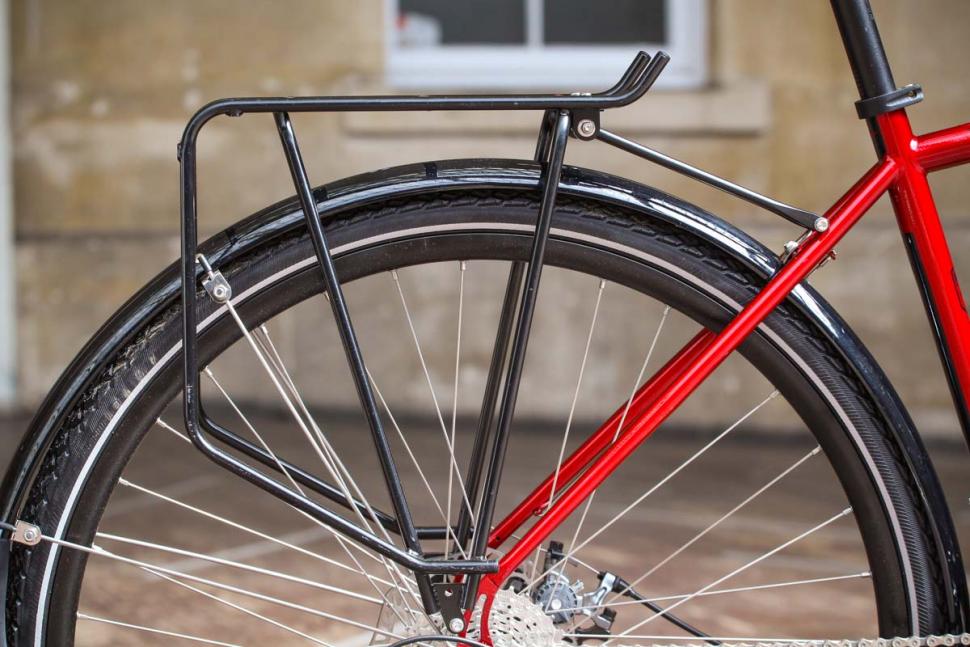
All you'll need to add are some panniers and bottles and you're good to go.

At the price, it's nice to get all the equipment you do, but sadly Genesis doesn't seem to represent quite the value that it once did.
An obvious competitor is the Trek 520 . That comes in at £100 cheaper yet has a front rack, high volume tyres, more upscale brakes and slightly better drivetrain components.
> Why your next bike should be a touring bike
Likely the decision about this bike will depend on which exact features you feel you need. Buying a complete build like this means you want something ready out of the box, and the deciding factor will be which particular set of features you require for your purposes.
This bike is thoroughly traditional in its outlook, and that's by no means a bad thing, though you should consider just what you need the bike for.
If you want something with all the latest standards that fits into a modern lineup you should probably look somewhere else. If you want an all-purpose machine that comes with all the gubbins you might ever fit or need, then it could be just the bike for you.

And that sums the Tour de Fer up quite well. It's a bike that will be ready when you are, that won't question the abuse you throw at it and that will stick with you reliably day in and day out.
It won't have sensibilities about weather or surfaces or complain about being burdened by luggage. It will just bravely soldier on and support you in whatever cycling goals you have.
If you'll allow me to wax lyrical for a sentence or two. This is a bike's bike – a bike that's true to the spirit of what cycling is about. Sure, there are bikes out there that may be more glitzy or more refined, but it's a bike that is honest about what it is.
No-fuss machine for commuting, touring, leisurely outings and more – a bike that just lets you enjoy your ride
road.cc test report
Make and model: Genesis Tour de Fer 10
Size tested: Medium
About the bike
List the components used to build up the bike.
FRAME: GENESIS MJOLNIR SEAMLESS DOUBLE-BUTTED CROMOLY
FORK: CR-MO UNICROWN DISC
HEADSET: PRESTINE PT-1606 1-1/8" SEMI CARTRIDGE
SHIFTERS: SHIMANO SORA ST-R3030 / 3X9 SPEED
REAR DERAILLEUR: SHIMANO SORA RD-R3000 / GS CAGE
FRONT DERAILLEUR: SHIMANO SORA FD-R3030
CHAINSET: SHIMANO FC-R453 / 50-39-30T / XS, 165MM / S, 170MM / M-XL, 175MM
BOTTOM BRACKET: SHIMANO BB-ES300 68-121MM
CASSETTE: SHIMANO CS-HG300-9 / 11-32T
RIMS: JALCO DD24 / 36H
HUBS: KT K08F/K08R 36H / FRONT / REAR / 6-BOLT
SPOKES: STAINLESS STEEL 14G
TYRES: SCHWALBE MARATHON MONDIAL 700X35C
BRAKES: PROMAX DSK-717 DISC BRAKES W/ 160MM ROTORS
BRAKE LEVERS: SHIMANO SORA ST-R3030
HANDLEBAR: GENESIS X-RACE PRO / 16DEG FLARE / XS, 400MM / S-M, 420MM / L-XL, 440MM
GRIP TAPE: VELO TAPE W/GEL
STEM: GENESIS AS-027 / + - 7DEG / 100MM
SADDLE: GENESIS ROAD COMFORT
PEDALS: NW-99K W/ TOECLIP
SIZES: XS S M L XL
CHAIN: KMC X9
Tell us what the bike is for and who it's aimed at. What do the manufacturers say about it? How does that compare to your own feelings about the bike?
Genesis says, 'The Tour de Fer 10 represents our vision of affordable escapism. A bike designed for the sole purpose of carrying rider and luggage long distances efficiently and in comfort, without leaving a sizeable dent in your pocket. We put it together as affordably as possible without cutting corners that would've been detrimental to the ride or long-term ownership. This meant choosing rugged, reliable kit that will last the high mileage for which we intend the bike to be used. Most of what makes it so good for touring is also 100% applicable to commuting. Everyday practicalities like large volume, puncture resistant Schwalbe Marathon tyres, tough 36H wheelset, powerful, controlled disc brakes, Tubus Cargo rear rack and custom length and extra-long Chromoplastic mudguards. Tour de Fer 10 is just as suited as a daily commuter as it is a cross-continent tourer.'
Where does this model sit in the range? Tell us briefly about the cheaper options and the more expensive options
This is the entry-level model. The more expensive models come similarly equipped, though with higher-end gears and dynamo lighting.
Frame and fork
Tell us about the build quality and finish of the frame and fork?
Nice paint job, neat welds and detailing. Barrel adjusters were a little stiff.
Tell us about the materials used in the frame and fork?
Steel (Genesis Mjölnir Chromoly)
Tell us about the geometry of the frame and fork?
Relatively slack for stable handling when loaded.
How was the bike in terms of height and reach? How did it compare to other bikes of the same stated size?
No surprises here.
Riding the bike
Was the bike comfortable to ride? Tell us how you felt about the ride quality.
Comfortable and relaxed position, though I don't get on with Genesis saddles.
Did the bike feel stiff in the right places? Did any part of the bike feel too stiff or too flexible?
It has the flex you'd expect of a steel frame, which adds comfort.
How did the bike transfer power? Did it feel efficient?
It's a heavy bike and is not built for sprinting. Once up to speed it rolls happily along.
Was there any toe-clip overlap with the front wheel? If so was it a problem?
How would you describe the steering? Was it lively neutral or unresponsive? Neutral.
Tell us some more about the handling. How did the bike feel overall? Did it do particular things well or badly?
It's a heavy bike, but rolls along happily with predictable and reliable handling.
Which components had the most effect (good or bad) on the bike's comfort? would you recommend any changes?
I didn't get on with the saddle.
Which components had the most effect (good or bad) on the bike's stiffness? would you recommend any changes?
Not really relevant for a bike like this.
Which components had the most effect (good or bad) on the bike's efficiency? would you recommend any changes?
It's nice to have a triple chainset for churning up steep hills when fully loaded.
The drivetrain
Tell us some more about the drivetrain. Anything you particularly did or didn't like? Any components which didn't work well together?
Basic groupsets just work so well nowadays.
Wheels and tyres
Tell us some more about the wheels.Did they work well in the conditions you encountered? Would you change the wheels? If so what for?
Standard fare wheels, built up with 36 spokes for a sturdiness that will withstand a lot of load and abuse.
Tell us some more about the controls. Any particularly good or bad components? How would the controls work for larger or smaller riders?
A decent and reliable spec. Middle of the road and likely a good compromise for everyone.
Anything else you want to say about the componentry? Comment on any other components (good or bad)
I didn't get on well with the mechanical disc brakes, which provided very limited stopping power.
Your summary
Did you enjoy riding the bike? Yes, more than I expected.
Would you consider buying the bike? Not for my use case.
Would you recommend the bike to a friend? If they're looking for a fit and forget solution to do everything with.
Use this box to explain your overall score
It's a good bike for the thing it's designed to do: load it up, carry everything you need and take it on an adventure.
Overall rating: 7 /10
About the tester
Age: 26 Height: 176cm Weight: 75kg
I usually ride: My best bike is:
I've been riding for: 5-10 years I ride: A few times a week I would class myself as: Experienced
I regularly do the following types of riding: road racing, commuting, touring, general fitness riding, fixed/singlespeed, mountain biking
Help us to fund our site
We’ve noticed you’re using an ad blocker. If you like road.cc, but you don’t like ads, please consider subscribing to the site to support us directly. As a subscriber you can read road.cc ad-free, from as little as £1.99.
If you don’t want to subscribe, please turn your ad blocker off. The revenue from adverts helps to fund our site.
Help us to bring you the best cycling content
If you’ve enjoyed this article, then please consider subscribing to road.cc from as little as £1.99. Our mission is to bring you all the news that’s relevant to you as a cyclist, independent reviews, impartial buying advice and more. Your subscription will help us to do more.
Add new comment
14 comments.

Used to love genesis bikes but if you visit their website you will see they have lost the plot on pricing.
- Log in or register to post comments
Quote: Mjölnir double butted 4130
Goodness, a bike with disks that isn’t the greatest Road.cc?
Have we now reached peak disk BS and can now talk constructively about how they have benefits and limitations in specific applications? Weird.
I built up a tourer for doing LEJOG around last year's frameset, the only difference being the tubes are Reynolds 725 rather than Mjolnir. The geometry is identical.
The comment around unloaded handling is spot on... When I was training, I took it up Great Fun Fell with just a rackpack and some Tangfastics on the back. It was fine going up, but scary coming down - 20% twisty bends at 40mph with the back end all over the shop was not fun. Theres some big drops off the edges of that road!
Loaded up though, the bike handles brilliantly. I did many fast descents with ease on it and while the steering might not be the fastest it is reassuringly stable.
I've got an earlier version of this bike when there was only one Tour De Fer model. It came with bar-end shifters, a trekking/MTB triple with a much more suitable gear range (44/32/22 rings with an 11-32 cassette) for fully loaded touring and both front and rear racks. Brakes were TRP Spyres which most people reckon are about the best cable discs going but I haven't been particularly impressed long-term. List price was IIRC £899 and was much better value for money than the TdF 10. To make it even better value I got it at the end of the season right before Genesis changed it to a flat-bar tourer. The current model's Sora equipment might be posher but IMHO not so relevant for a bike intended for loaded touring and bumps up the price.
Having said that, although I find the bar-end shifters great for on-road use they do make off-road riding a bit "interesting" sometimes. Like the reviewer I find the bike very stable at all times and would agree that loading it up seems to actually improve the handling a tad unlike tourers made of lighter gauge tubing. I also agree that the stock tyres aren't the most confidence inspiring when the roads are greasy and when I can find some 32mm Conti GP 4 Seasons at a reasonable price I'll stick some on for this winter.
As a multi-purpose machine for commuting and clubruns through the winter, touring or even "bikepacking" it's served me pretty well to be honest but I'm not sure I'd buy the TdF 10 at the current price.
The Trek 520 looks a bit better in some respects but as others have commented the aluminium fork would put me off. Why bother saving ~300g on a bike destined to be lugging loads of stuff around. There's no denying the 1.25kg Genesis fork is heavy and unyielding (no lovely steel spring in that beast) but at least I know it will take anything I throw it at.
daccordimark wrote: I've got an earlier version of this bike when there was only one Tour De Fer model. It came with bar-end shifters, a trekking/MTB triple with a much more suitable gear range (44/32/22 rings with an 11-32 cassette) for fully loaded touring and both front and rear racks. Brakes were TRP Spyres which most people reckon are about the best cable discs going but I haven't been particularly impressed long-term. List price was IIRC £899 and was much better value for money than the TdF 10. To make it even better value I got it at the end of the season right before Genesis changed it to a flat-bar tourer. The current model's Sora equipment might be posher but IMHO not so relevant for a bike intended for loaded touring and bumps up the price. Having said that, although I find the bar-end shifters great for on-road use they do make off-road riding a bit "interesting" sometimes. Like the reviewer I find the bike very stable at all times and would agree that loading it up seems to actually improve the handling a tad unlike tourers made of lighter gauge tubing. I also agree that the stock tyres aren't the most confidence inspiring when the roads are greasy and when I can find some 32mm Conti GP 4 Seasons at a reasonable price I'll stick some on for this winter. As a multi-purpose machine for commuting and clubruns through the winter, touring or even "bikepacking" it's served me pretty well to be honest but I'm not sure I'd buy the TdF 10 at the current price. The Trek 520 looks a bit better in some respects but as others have commented the aluminium fork would put me off. Why bother saving ~300g on a bike destined to be lugging loads of stuff around. There's no denying the 1.25kg Genesis fork is heavy and unyielding (no lovely steel spring in that beast) but at least I know it will take anything I throw it at. Mark.
That's the thing though, despite the modern equipment this is still heavier than the old bog standard R531 Dawes Galaxy with racks/guards, it's 4kg heavier than my commuter/utility do-it-all hybrid with rack/guards/cages, it's heavier by over 3kg than a Roux Menthe with R525 with mudguards (no rack) and roughly the same as the Roux Etape 250 https://road.cc/content/review/82472-roux-etape-250-2013 which is still available for as low as £600. The Ridgeback Panorama is available for well under £1000 too.
If you don't think 4kg makes a difference when touring or commuting, go put two bricks in your panniers and come back to me.
As for forks, I find my 650g carbon mudguard forks (with low rider mounts too) will take everything I can throw at it includingcrashes and motor vehicles driving into them, why add more weight when it's not necessary nor compromise robustness and even be able to increase comfort?
BehindTheBikesheds wrote: daccordimark wrote: I've got an earlier version of this bike when there was only one Tour De Fer model. It came with bar-end shifters, a trekking/MTB triple with a much more suitable gear range (44/32/22 rings with an 11-32 cassette) for fully loaded touring and both front and rear racks. Brakes were TRP Spyres which most people reckon are about the best cable discs going but I haven't been particularly impressed long-term. List price was IIRC £899 and was much better value for money than the TdF 10. To make it even better value I got it at the end of the season right before Genesis changed it to a flat-bar tourer. The current model's Sora equipment might be posher but IMHO not so relevant for a bike intended for loaded touring and bumps up the price. Having said that, although I find the bar-end shifters great for on-road use they do make off-road riding a bit "interesting" sometimes. Like the reviewer I find the bike very stable at all times and would agree that loading it up seems to actually improve the handling a tad unlike tourers made of lighter gauge tubing. I also agree that the stock tyres aren't the most confidence inspiring when the roads are greasy and when I can find some 32mm Conti GP 4 Seasons at a reasonable price I'll stick some on for this winter. As a multi-purpose machine for commuting and clubruns through the winter, touring or even "bikepacking" it's served me pretty well to be honest but I'm not sure I'd buy the TdF 10 at the current price. The Trek 520 looks a bit better in some respects but as others have commented the aluminium fork would put me off. Why bother saving ~300g on a bike destined to be lugging loads of stuff around. There's no denying the 1.25kg Genesis fork is heavy and unyielding (no lovely steel spring in that beast) but at least I know it will take anything I throw it at. Mark.
You're not wrong there, it is ridiculously heavy! A lot of that comes from the stock tyres on mine which weigh roughly 1kg each and are far heavier than anything I ever put on my original 531 tourer BITD. That bike did some seriously laden touring but it was noticeably flexy when loaded up compared to the TdF. I also wouldn't have had the confidence to take it on the kind of off-road terrain that the TdF has done with me. That's not to say it wouldn't have survived as many an old member of the Rough Stuff Fellowship would probably tell me but that's my personal choice.
To compare it to the Roux Menthe is meaningless in the context of weight as they are made for different things. The equally heavy Roux Etape 250 is a proper comparison and as you say still around for much less money than the current TdF which as I've already aluded to isn't good value.
Looking around I can't find a disc-braked Panorama for well under £1000 although there are some of the rim-braked ones still available at those prices which again just reinforces what I said about getting good value by buying end-of-line bikes. I never would have paid £899 for my TdF but at £699 I considered it just about worth the money.
Your comment about 4kg made me laugh - where did I ever say 4kg doesn't make a difference? You'll get no argument from me there, I would love to save 4kg off my TdF if and only if every single component was to the same spec. So that means disc brakes, super tough 35mm tyres, 19mm rims, 36 spokes in each wheel, a steel frame with a stiff down tube to take the heavy touring loads etc. etc. I suspect that would be possible with a bigger budget than I had at the time I bought the bike but that's hardly the point.
Your carbon forks sound pretty tough, I'm not sure many forks would survive a direct hit from a motor vehicle no matter what they're made of. For some illogical reason I still prefer steel forks for every day riding and loaded touring, I can't defend it with facts I just don't have faith in carbon. I rode carbon-bladed forks with an aluminium crown and steerer in my Kinesis TK2 for years without worrying but that was only used for commuting. Eventually though I lost confidence in them when I noticed grooves in the fork crown made by the mudguard and started to see the join between the carbon and the aluminium. On the other hand the monocoque carbon forks in my "race" bike have my full confidence. As for the comfort factor neither of those carbon forks flex in the same way as steel does or soak up the vibration any better so for me I can't see where the comfort claims come from. Even with the unyielding TdF fork there's much more gain to be had from compliant tyres inflated to sensible pressures.
Getting back to the reviewed bike, yes it's not good value for money but seeing as you mentioned the Ridgeback Panorama the current disc-braked version is more expensive and even heavier (not that I think that matters) even with it's better quality 725 main tubes. So it's not like the TdF stands out like a sore thumb compared to what's currently being offered by manufacturers.
Out of interest what is your commuter/utility do-it-all hybrid? I think I've seen you mention it before but can't remember what it is.
Pinnacle Dacite good option for £950? https://www.evanscycles.com/pinnacle-dacite-1-2019-touring-bike-EV318241 , has TRP Spyres better than Promax, also a better gear range for properly fully loaded touring imo 44/32/22T up front and 11-34T on the back. I don't think the 30/32 on this is amazing when lugging panniers and tent and that. Also has the same great Tubus rack and better SKS guards. Bar end shifters though-if you can hack 'em.
Sora and Mechanical disks for £1200? Not the best value.
a1white wrote: Sora and Mechanical disks for £1200? Not the best value.
You can’t get hydraulics without going to 105, at which point you lose the triple. I suppose you could go to tiagra with hy/rd brakes, but that’s as close as you’d get.
Youre paying for the frame and the name, though, let’s be honest. My Genesis cost the thick end of £700 and that’s with rim brakes and no groupset at all.
vonhelmet wrote: a1white wrote: Sora and Mechanical disks for £1200? Not the best value.
Yeah good points. nice bikes, but the prices have creeped up lately for sure.
It's strange that the review says Genesis doesn't seem to represent the value it once used to. I'm not sure they've ever represented good value equipment-wise, which given that they spec Shimano components and their parent company is a Shimano distributor has always felt a little like price gouging to me.
A lack of power is not “a feature inherent to mechanical disc brakes”. I’ve got TRP Spyres with compressionless cables that will loosen the fillings in your teeth if you yank on them.
Now a lack of modulation is another matter, but you didn’t say that.
vonhelmet wrote: A lack of power is not “a feature inherent to mechanical disc brakes”. I’ve got TRP Spyres with compressionless cables that will loosen the fillings in your teeth if you yank on them. Now a lack of modulation is another matter, but you didn’t say that.
i agree, lack of power? Get a captain crush hand strengthener.
Latest Comments
Shetland Islanders must be a right bunch of Jessie's these days. The total population of the islands is less than 23,000 and Lerwick where the...
The same author seems to show something that looks like a shared space in his peice about the 85th percentile speed. However rather than an fully...
Strange how report results tend to match the expectations of those that paid for them.
It should be noted that socialism doesn't prevent folk from starting or running their own succesful busineses. It's about making sure no-one get...
London does seem to exist, making it REAL, and also seems to be part of the WORLD, it is not a figment of someone's imagination, so by being there,...
Look at London and the way that better infrastructure has encouraged cycle use. On some stretches the bicycle is the most numerous vehicle type....
Meanwhile the police throw significant resource at the Angela Rayner tax issue that should/could be handled by HMRC....
Precisely, they pick and choose when it suits them. And yet people still vote for them, which is where they absolutely rely on the levels of...
It's when I noticed that even the motorways are riddled with potholes that I realised just how bad it's got.
And a seat/saddle bag is supposedly in an optimum aero position. Tri riders very often keep their water bottles behind the saddle. Could save you...
Related Reviews
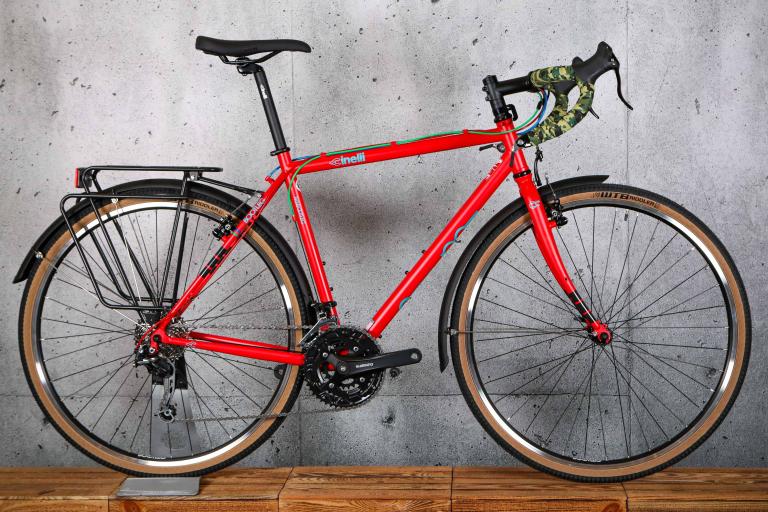
Cinelli HoBootleg
Comfortable to ride on all kinds of terrain, with a certain 'old school' charm, if pricey against the competition
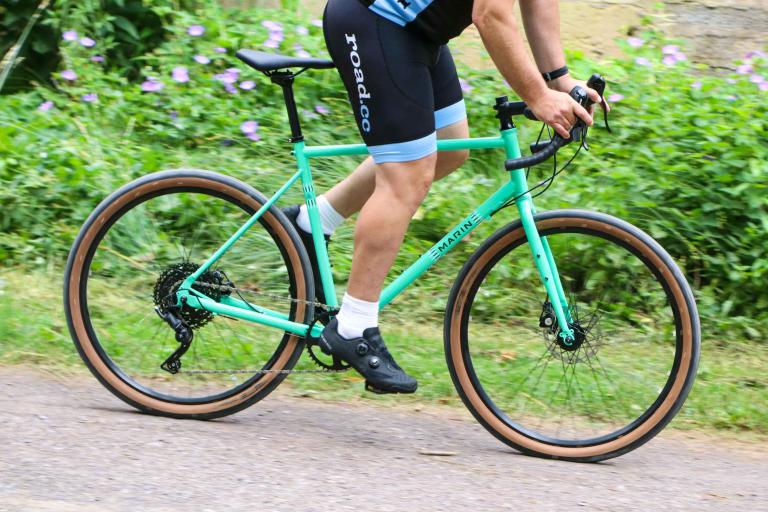
Marin Nicasio+
Heavy, and the brakes are mediocre, but a comfortable bike for rides on and off-road
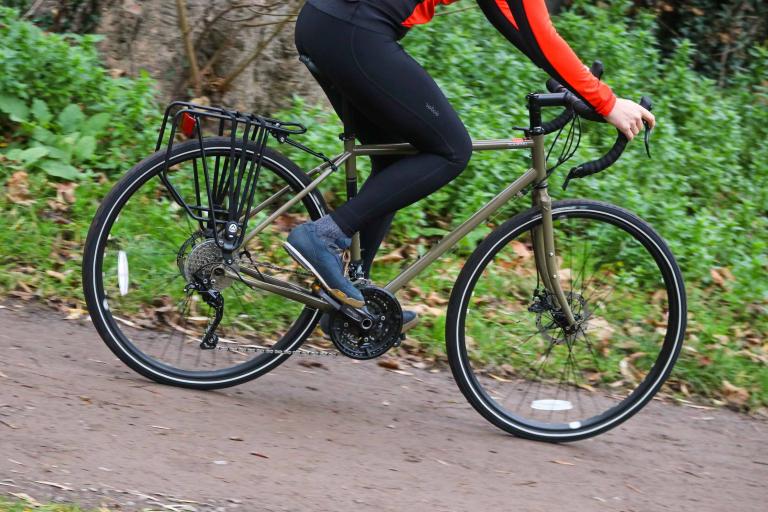
Fuji Touring Disc 2022
Classic steel tourer for anyone wanting to load up, sit up and enjoy the ride – after changing the tyres...
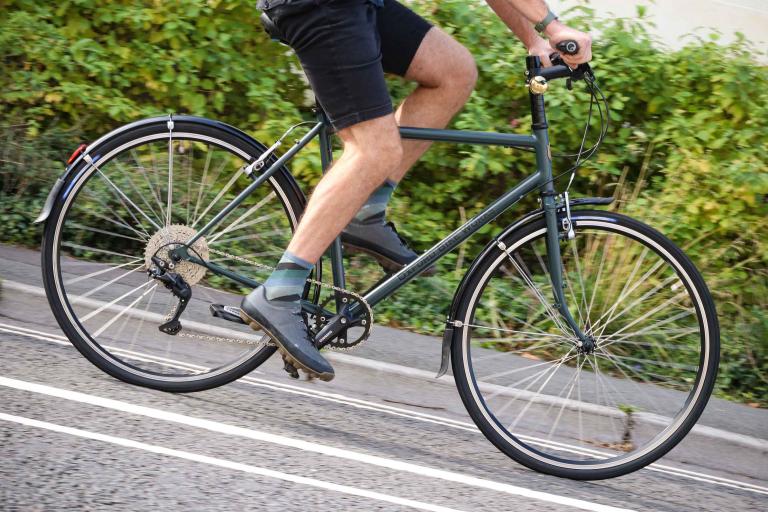
Oxford Bike Works Model 1E
Classy handmade steel frameset in a simple 1x setup makes for a quality commuter or lightweight tourer
- Starting Out
- Expedition & Alpine
- Destinations
- Walls & Training
- Crag Access
- Winter Climbing
- Photography
- Culture Bunker
- Lost & Found
- Lifts & Partners
- For Sale/Wanted
- Premier Posts
Genesis Tour de Fer 10 FB v Tour de Fer 20 FB
I have decided that if I am going to take this bike touring further, new bikes are needed, that will at least take panniers. I have decided flat bars are the way ahead. Any bike will do that will take panniers, but something a bit better may make the process more pleasant. I did consider Rohloff hubs, but bikes with them are super expensive, and possibly more of a target for thieves.
If looking at flat bar bikes in the UK the choice seems to narrow down, I have considered the new one from Decathlon, but its not that cheap and I have a decathlon bike, which is Ok but I did need to take it to a local bike mechanic to get it sorted. I have narrowed it down for the moment to Genesis Tour de Fer 10 FB https://www.genesisbikes.co.uk/genesis-tour-de-fer-10-fb-vargn21400 and Tour de Fer 20 FB https://www.genesisbikes.co.uk/genesis-tour-de-fer-20-vargn21420 . Now I have sold beds for many years and people often ask me questions like what's the difference between a £1000 bed and a £1600 bed, and I can tell them the specifications but tell them its personal preference and that they may prefer the cheaper one. What I do not tell them is that in reality I often do not think they can tell the difference and that all they need is a decent new bed and that anything will be better than the 20 year old thing they are sleeping on. So is this really the case with these two bikes, and if they fit right, either will suit? ps. it maybe I will have to have what I can get as bikes are in short supply ATM, but time is not of the essence and I can wait pps, the worst people to sell beds to are engineers and the people who most often get it wrong are engineers. They over think it and get too involved in the specifications.
Are you set on a Genesis?
https://spacycles.co.uk/m1b0s225p0/Bikes/Touring
or https://www.thorncycles.co.uk/bikes
Off the top of my head make very nice bikes.
Also decathlon - I used my Triban 500, flat bars, 3 cogs at the front (i.e. granny gear) for a little tour over to the IoM a few years back (stopped at B+B, not roughing it!)
> Are you set on a Genesis?
> https://spacycles.co.uk/m1b0s225p0/Bikes/Touring
looked at the Spa cycles, maybe worth another look.
> or https://www.thorncycles.co.uk/bikes I think I want a kickstand, and I suspect that I would clash with the owner, maybe I might even be a bit like him
> Off the top of my head make very nice bikes.
> Also decathlon - I used my Triban 500, flat bars, 3 cogs at the front (i.e. granny gear) for a little tour over to the IoM a few years back (stopped at B+B, not roughing it!) I have a Triban 500 with drops and want flats, reasonable bike, but I think maybe something a bit more expensive will be nicer.
Well, that's not an easy choice! They're are not just two versions of the same thing at different price points. There are significant differences with pros and cons of each one.
Overview: They both seem to be the same frame so the heart of the bike is a constant.
CdF 10: This only has a compact double chainset. If you're looking for a loaded touring bike, it immediately reduces your range of low gears. The upgrade path would mean spending more money / faff. It's better to have gears in reserve than always wish you had more. I know Bradley Wiggans (et al) have toured with all their camping gear for a family of five on a single speed bike, but . . .
The cheaper bike also has hydraulic disk brakes. This is more of a personal choice - they're either a huge improvement over mechanicals or something that's going to develop a leak and leave you stranded at the top of the Galibier with night drawing on and four foot of snow forecast . . . I've always thought that even cheap mechanicals are more than adequate for touring.
It doesn't have much ancillary stuff like racks and mudguards and cages.
CdF 20: This has a triple chain set and pretty low gears which is great. But . . . although some of the extra money has been spent on better quality drivetrain, a lot of it has gone on mudguards, racks and a dynamo lighting system. This all probably represents good value for money if it's the stuff you want. Certainly the racks and mudguards are fine, but the dynamo / front wheel has pros and cons. With GPS and phones, having some on-board charging is great. As long as the stuff it comes with is the basis of a charging system that works for you, then that is great. But don't buy stuff up front that you will want to replace.
Which takes us to wheels. Reliable wheels pretty much underpin touring happiness. With either of these, once you've done a 800 / 1000 miles, take them to a good wheel builder and have them re-tensioned. Well worth the £30.
So if the cheaper CdF10 had a triple I would say that was the best buy which would leave you with £650 to buy racks / mudguards / cages and go a long way to buying a set of touring wheels from Paul Hewitt with the charging system of your choice at some point down the line. But as the cheaper bike only has a compact, I wouldn't go there. I think I would broaden my search to Hewitt / St John's Street cycles / Edinburgh Coop / Ghyllside Cycles / Spa Cycles / etc.
it's the same bike with cheaper / more expensive drive train & gearing components, the more expensive one has:
more gears,
better gear mechs (although the level of improvement is possibly moot),
nicer looking cranks,
front rack and lights.
if you test-rode each you might be able to feel the difference; e.g. spongy gear levers, feeble plasticy gear click..... or you might not.
Rohloff hubs are pretty niche and probably not worth the money unless you're going round the world. Plenty of people use them for other stuff and like them but they are different from derailleur gears and feel quite different. I've recently got a shimano hub gear (alfine 8) for my commute bike and it's great for that job but made me think I wouldn't bother with a hub gear for touring.
basically what Jim Said. As per the other thread, not having enough gears can really ruin stuff for you and the compact on the 10 is going to leave you short. The Genesis are great value for money if you want everything they have on them (the tubus racks are nice), but if you don't want the hub dyno etc you can get more for your money elsewhere.
I don't know for sure, but with that hub dyno it may not even be possible to plug in ancillaries, and likely that it would have to be a battery pack which you then use to charge phones etc seperatly as you have to spend a lot on a dyno to get a clean enough signal to charge fickle electronics directly.
Genesis bikes are pretty well thought out. I've got a Longitude which with different wheels and tyres I use for mountain biking, off-road touring and on-road touring.
Something to think about is exactly what you will be doing as this will inform what type of bike will be best.
If it's onroad, summer touring in not very remote areas then a lot of what's on that more expensive genesis won't really be necessary. For that kind of touring I've never felt the need for dynamo lights and it's a matter of preference whether you want front panniers.
Also, if you are set on flat bars that opens up a whole lot of options for hydraulic discs which are definitely preferrable to the mechanical ones on both those bikes. I suspect they've gone mechanical for self repair/maintenance but if you're not in really remote areas there's no reason to choose mechanical discs.
https://www.genesisbikes.co.uk/genesis-tour-de-fer-10-fb-vargn21400 Chainset unknown but triple on photo Shimano Alivio SL-M4000 3 x 9 Speed Shimano CS-HG400-9 11-32T
https://www.genesisbikes.co.uk/genesis-tour-de-fer-20-vargn21420 Shimano FC-T611 44-32-24T 170 mm Shimano Deore SL-M6000 3 x 10 Speed Shimano CS-HG500 11-34T
https://www.cyclesolutions.co.uk/75184/products/genesis-tour-de-fer-10-2021... SHIMANO FC-T4010 48-36-26T SHIMANO CS-HG400-9 11-32T 9 speed 26T -> 32T cassette lowest gear 48T -> 11T highest gear
9 speed and if you really need lower gears RD will take 12-34T or 12-36T cassette 26T->36T lowest gear is almost the same as 24T->34T for 10 speed
48-26+36-12=46 <-- almost within 45T capacity of Alvio RD-M4000, unlikely to be an issue 10 speed 24T -> 34T cassette lowest gear 44T -> 11T highest gear
Worth contacting seller to verify exact chainset and exact rear derailleur.
https://www.chainreactioncycles.com/shimano-alivio-m4000-9sp-rear-derailleu... <-- 36T max sprocket
https://www.tredz.co.uk/.Shimano-CS-HG400-Alivio-9-speed-cassette_72777.htm <-- 12-36 cassette
I reckon 9 speed and change cassette to 11-34 or 12-36 if necessary (it might not be). New cassette is a cheap upgrade, may need new chain with some extra links.
Thanks everyone, here is my plan. This year for sure a week or more touring Lincolnshire, Suffolk and Norfolk, camping, maybe easter, but covid dependent. I do not know the area, so thats a draw and I believe its not hilly, so thats a draw. ASAP a longer tour in Europe, camping where possible, maybe linking up the Rhine, Moselll and Rhone. If we are enjoying this, cycle to Turkey, I believe this is possible and not too extreme, as for the first 1000 miles or so its not too hilly, and I think by then I/we will be well up to hills. I was going to get a camper van, but TBH amongst many other things, I like meeting local people and think that in a camper van you will always be "apart" from the locals, but on a bike you appear more normal and can approach people and be approached more easily. I cannot foresee cycling for days across a dessert or mountain range, why do that when there is a perfectly good train. I certainly need to get my head around these gear numbers and sprocket sizes,
>I cannot foresee cycling for days across a dessert or mountain range
Firstly, don't over imagine the difference between the middle of France and middle of no-where when it comes to bike shops and repairs. Neither is over endowed with places that sell touring bike bits, and those places are getting rarer every year. Bikes are really reliable if you take care of a few basics, carry the odd spare and have a modicum of skill. So the preferred outcome is zero breakdowns as this is the most enjoyable and time efficient way to spend your holiday. And it's neither that expensive or difficult to achieve.
> I certainly need to get my head around these gear numbers and sprocket sizes
There's plenty of tutorials on the internet, but it'll all remain a mystery until you reduce all the different sprocket / wheel size / gear combinations to a simple single number you can then compare. The 'continentals' have a system that computes it all as the distance advanced per pedal stroke, but that requires difficult things like 'pi' and millimeters. The simpler alternative is the good old British system that converts all the gear ratios to the equivalent diameter of a penny farthing front wheel, measured in inches. Something we can all relate to. In this system you want to make sure you have a bottom gear of about 18 inches ( a diddy, easily pedalled front penny farthing wheel) and forget about anything much over 100 inches ( clearly a massive diameter for the front wheel of a penny farthing). And there you have it.
This website can be useful to compare gear ranges and spreads and can have a play with various options to see how they compare.
http://ritzelrechner.de/
This should be the setups on the 2 bikes, not sure on the chain ring sizes of the TdF 10
http://ritzelrechner.de/?GR=DERS&KB=22,32,44&RZ=11,12,14,16,18,21,2...
Of the 2 genesis bike I would probably go for the TdF 10 and upgrade the brakes to a hydraulic discs. Unless you are planning on wanting to charge phones and other accessories whilst riding in which case a dynamo and converter are useful although can be slow compared to using a battery pack and recharging it every few days from the mains.
Flat bar. Excellent choice.
This will also open up access to MTB components, like proper disk brake systems.
I really think it will be worth us going to this test facility https://www.defietser.nl/fietsen/ we actually have a credit with P and O for Hull - Zeebrugge, so that cost is already paid. The problem with these bikes is it all get so technical, maybe I should be focusing on finding my size and looking at secondhand bikes more. Where would you look for second hand? Gumtree Ebay Facebook Cycle Forums anywhere else. I am 5' 11.75" is there a number that I should particularly look for that would indicate size please? I am thinking if I spent £700 or £800 wisely on a secondhand bike, then £400 or so with a good bike mechanic, that might be the way ahead.
> I am thinking if I spent £700 or £800 wisely on a secondhand bike, then £400 or so with a good bike mechanic, that might be the way ahead.
The price of second hand bikes is crazy at the moment as a result of the limited supply and excess demand triggered by Covid.
Not really my type of bike but I'm pretty shocked that a flat bar bike at over £1,000 let alone one at over £1600, wouldn't come with hydraulic brakes. My "sports hybrid" that I had nearly 15 years ago had deore hydraulic brakes and they were superb. It was for a long time one reason to get a flat bar over a drop bar, because hydraulic technology for brakes was becoming the norm on mountain bikes so could go onto flat bar hybrids and tourers, while hydraulic integrated brake and gear levers on drop bar bikes were prohibitively expensive. But now you can get drop bar gravel bikes for £1,000 with full hydraulic brakes so I'm not sure why they wouldn't use them on a flat bar tourer?
I went from that sports hybrid with hydraulic brakes to a cyclocross bike with mechanical disc brakes, and the brakes with the worst thing about the cyclocross bike, which otherwise I loved. When I replaced it with a gravel bike a couple of years ago having hydraulic brakes was one of my biggest requirements. The tiagra hydraulics on my new bike you are superb.
A good time to sell our Triban 500s then, I will wait until it warms up a tad.
I think the most important thing for cycle touring is to find a bike that is comfortable to ride, is well maintained and has durable but easily serviceable parts.
In addition to Thorn and Spa, the Oxford bike works site is worth looking at for specification ideas.
I like Genesis bikes but looking at both of these I'm not persuaded at the price. The basic geometry of the Croix/Tour De Fer frame is superb, long standing and versatile but neither of these offers it in a particularly high quality steel, so weight will be high, especially for the TdF10 which I think must be a lower quality steel than the Reynolds 725 used for the TdF20. I'd describe the components on both bikes as "adequate" but they do make compromises. Given your plans, I'd suggest the TdF20 is the one to go for because of the improved 10spd shifter/derailleur quality but your paying a lot for that and still not getting hydraulic brakes. The pannier racks look good and are a nice inclusive accessory but I'm less convinced by the dyno hub and light. I run SP dynamo hubs but only when I need to. Like all hubs they have a limited lifespan but dynamo hubs are generally both shorter lived and hard/impossible to service. So I'd suggest you fit a standard wheel for general use, offsetting the benefit of an inclusive dynamo. SP hubs are widely used and reliable but the model fitted here is not one I recognise and so may be a low cost production. B&M lights are top quality but I would assume the TdF20 is fitted with one of their lower end models and you may well be better off with a separate, higher quality purchase of lighting. Furthermore, battery/USB light performance has developed to a level where the benefit of dynamo lighting is questionable. The dynamo is a valuable tool for charging navigation devices and phones while touring but you would need to add a converter to this package before this would be possible. A similar flat bar bike that I think looks better value and better "balanced" in terms of component quality, is the Giant Toughroad SLR1. It has an aluminium frame which some would say is not an option for touring but frankly I wouldn't agree unless you are going to ride really rough and hard. On the plus side, the Toughroad will be lighter than the Genesis models. The high volume tyres will add comfort but will also be a bit slower but could simply be swapped for narrower tyres to suit the ride. Unless speed is the top criteria, 50mm is an excellent tyre size for comfortable loaded leisure touring, although 42c-35c is the traditional range. The Toughroad also comes with pannier racks and has all round better componentry, including hydraulic brakes and an excellent 2x10 gear range for touring that should see you coping with the stiffest climbs even with full loads. At around £1200 it's worth a look.
Thats great, thanks for taking the time to post that. I have read through, but will again.
For what it's worth, I'd be wary of a flat bar for an extended ride - very limited hand positions. However, stick with the principle, buy a bike with flat bars and then buy an after-market bar with a bit of a sweep. Far more comfortable and still compatible with a wide range of gear and brake levers. Have a look here https://www.sjscycles.co.uk/handlebars-comfort-cruiser/
We fitted some to my wife's sit up and beg electric bike and it's transformed. Watch the length of hydraulic hoses though (cables are cheap).......
Fog penny-fathering gear inches, you need Sheldon Brown gear calculator (google it)
> For what it's worth, I'd be wary of a flat bar for an extended ride - very limited hand positions.
I always held to this advice until I realised that my MTB had flat bars and I was quite happy doing long days on it! If flat bars work for someone there's no reason for them to look for alternatives.
That said, I love the Planet X Jeff bars I now have.
> I always held to this advice until I realised that my MTB had flat bars and I was quite happy doing long days on it! If flat bars work for someone there's no reason for them to look for alternatives.
> That said, I love the Planet X Jeff bars I now have.
Totally. I did a c. 12000km ride on flat bars. Never found the lack of hand positions an issue! For long distance touring flat bars are still the default option - your body soon adjusts to the bike you’re riding.
There's review of the TdF 30 in the CTC magasine (Two grand tourers).
Generally quite impressed but makes the same point that the gears are too high for a touring bike. Reckons a better alternative is one of the Spa cycles offerings at a little over half the price.
https://spacycles.co.uk/m1b0s225p4106/SPA-CYCLES-725-Trekking-Bar-Steel-Tou...
Does it say that in the article, I will have another look. That Spa bike looks the ticket. Not keen on those bars, but otherwise, looks great. I saw the thing about gears and for me the gears are really important, joking aside I want to give myself a shot at riding up some hills. Also Harrogate is a nice drive out for me so a shop I can visit, lockdowns permitting. Thank you.
Yes in the summary and then lists the Spa Wayfarer in the 'Other Options' box. But the Spa website is a bit of a mess and I couldn't see exactly which one they favoured.
But their 725 Trekking looks okay. It has rim brakes but I've never found these a problem with touring bikes. And if you want flat bars (available as a no cost option from Spa) then V-brakes are a perfectly powerful option.
The other thing with that Spa, is he sources proper touring triple chainsets. The one offered is with your choice of rings including a 24t bottom. That with a 36 at the back gives you the 18inch bottom gear which is about as low as is practicable.
TBH we favour rim breaks, because when we have used our Mountain Bikes on the road the Disc Brakes seem to squeak, which is annoying. Thank you for the advice on the gears at the end of your posting. I think we shall have a ride to Harrogate as soon as it is practicable.
Brakes - as opposed to 'breaks' :
One option some favour is to have a V-brake on the front fork (so that you can have a more compliant/comfortable fork) and disc on the back (so you don't have to worry about overheating rims on long hot downhills). Not a specific recommendation from me, just what I've heard.
Latest Jobs 3 New

Jobs Sales - Needle Sports
Elsewhere on the site.
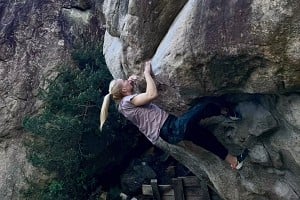
Newsflash Fontainebleau Big Five in a day for Janja Garnbret
Janja Garnbret has climbed all five of the Fontainebleau 'Big 5' boulders in a single day, on her very first trip to the forest.

Podcast Factor Two - S3 Ep.11: Birth Pains of New Nations - Pete Oxley

Gear News The Art of Climbing – Out Now


Press Release Arc'teryx Climb Academy returns to the Lake District: May 25th – 27th
- News, Current Affairs & Politics

- Cycling Forums
- Bikes & Buying Advice - What Bike?
Genesis Croix De Fer 30 - Thoughts and Possible Alternatives Please..?
- Thread starter wafter
- Start date 10 Feb 2020
I like steel bikes and I cannot lie..
- 10 Feb 2020
Not So Special One
steveindenmark
Legendary member.
I have the CDF 20. Great bike, but heavy.
Or go for the other Spa custom build CDF, same spec as above but with the, and I know you’re not keen, very well regarded TRP HyRd Disc brakes for £1195. https://www.spacycles.co.uk/m1b0s23p3986/GENESIS-Croix-De-Fer-Custom
CanucksTraveller
Macho business donkey wrestler.
SkipdiverJohn
Deplorable brexiteer.
Buy a decent quality secondhand vintage steel tourer. Plenty of real British made ones around, and you don't get all the marketing-driven throwaway shite engineering common in most new bikes. The Genesis looks decent though, and it is steel, but I wouldn't consider it especially good value or cheap.
wafter, PM if you wish. I will be willing to sell my 4 yr old, lightly used, stainless steel CdF, hydraulic disc brakes , 105 group set, 11spd. Maintained professionally. All in vgc. I guess it would suit anyone 2" either side of 6ft 1". Fulham based so transfer would be easy. At 78 yrs I am running down my "fleet".
Spiderweb said: I’m guessing the £1600 offer you’ve seen is from SPA Cycles. They have a custom CDF built buy themselves but with far superior hand built wheels and some other upgraded components. The description also lists SKS Chromoplastic mudguards too, All for £1490. https://www.spacycles.co.uk/m1b0s23p3993/GENESIS-Croix-De-Fer-Custom-Hydraulic Click to expand...
steveindenmark said: I have the CDF 20. Great bike, but heavy. Click to expand...
CanucksTraveller said: Gosh, you sound similar to me a couple of weeks ago! I have the same intentions roughly speaking, though I'll probably do very little off road. Mine was a choice between the Tour de Fer 10 (I'm not bothered about what groupset it has, simple was best for touring) and a small handful of other bikes, and my budget was lower. I thought very hard about the Spa Wayfarer but in the end I ordered the TdF 10 from the local shop. I take delivery tomorrow. Good luck with your choice! Lots of knowledge here. Click to expand...
vickster said: If you're a 54cm rider, this is a bit of steal (not steel though ) https://www.spacycles.co.uk/m1b0s221p3924/SPA-CYCLES-Elan-105-Hydraulic-(Ex-Demo) Click to expand...
SkipdiverJohn said: Buy a decent quality secondhand vintage steel tourer. Plenty of real British made ones around, and you don't get all the marketing-driven throwaway shite engineering common in most new bikes. The Genesis looks decent though, and it is steel, but I wouldn't consider it especially good value or cheap. Click to expand...
gbs said: wafter, PM if you wish. I will be willing to sell my 4 yr old, lightly used, stainless steel CdF, hydraulic disc brakes , 105 group set, 11spd. Maintained professionally. All in vgc. I guess it would suit anyone 2" either side of 6ft 1". Fulham based so transfer would be easy. At 78 yrs I am running down my "fleet". Click to expand...
chriswoody said: One direct alternative to the CDF 30 is a Kona Sutra LTD. Like the CDF it has a steel frame with a standard external BB. It uses the normal touring Sutra's steel frame, so it's a really comfy road bike, but is fitted out for off road riding with a SRAM 1 x groupset and hydraulic brakes. It's also festooned with mounting points for mudguards, racks and 5 bottle cages. There's space for really wide tyres. I've got the 2016 version and it's a cracking bike. Winstanleys have a 2019 one for sale at the moment: https://winstanleysbikes.co.uk/kona-sutra-ltd-2019-bike Possible downsides to this that I can see: The 1 x group set, whilst a joy to use and really simple is not to everyones taste and the gap between some ratios can be a bit noticeable on the road, but off-road it's a non issue. The price of a replacement rear cassette is astronomical however, and far outstrips a Shimano Equivalent. (and guess who didn't check that out before buying their bike! ) The fact that the Sutra uses unbranded cromoly steel, rather than Reynolds could be off putting to some folk. Personally I find it much stiffer off-road than my Reynolds tubed bikes though. If you can get the CDF at your LBS, then that is a massive plus point in it's favour as well. I really like it as a bike and nearly went for one myself, but the Sutra came up secondhand at a good price and I went with that instead. Click to expand...
wafter said: Thanks - I've heard it mentioned but not really paid that much attention, so will take a look. I must admit the groupset does put me off though; I'm not personally a fan of SRAM hardware and really struggle to buy into the whole 1x hype machine - is the simplicity and loss of weight really worth the massive gaps between ratios and overall reduced range? Perhaps less of an issue in dedicated off-road use, but I think I'd struggle on the road. Great point about the cost of the cassette too; which is pretty much a consumable I guess; especially if subject to a lot of off-road contamination. I certainly appreciate the suggestion and will do a bit of digging on the subject Click to expand...
chriswoody said: To be honest the gap between ratio's is not that noticeable in real life, like you said in your original post, your an uncompetitive cyclist not drawn to speed, much like myself. It's kind of hard to describe, but there are certain gears I'll hit where I'll lose a bit of momentum or suddenly find myself grinding instead of spinning. I don't find it a major hassle though, just noticeable after coming from a 3 x 9 set up. I do find myself changing gear much more though because of the simplicity of the set up and will often be able to keep up much more momentum as a result. I ride a lot on road as well as off and whilst it is better off-road, it's not a sluggish bike or difficult to ride. Reduced range is also not really a problem, looking at the gear table for a 3 x 9 set up, there is significant overlap in ratio's that effectively means you only have about 11 useable gears anyway. The SRAM set up has a 10 tooth cog on the back which see's me bombing along at nearly 30kph with no hassle, At the other end is a massive dinner plate of a cog, I'm just not sure how steep a hill the dinner plate will get me up! If the CDF offer wasn't so good, I'd really urge you to just try out a 1x system to see if it works for you or not. The SRAM system is not flawless, but it's a lot better than the naysayers would have you believe. Click to expand...
vickster said: @wafter £1575 in all sizes https://www.spacycles.co.uk/m1b0s221p3926/SPA-CYCLES-Elan-105-Triple-or-Double-limited-offer-(custom-builds) Click to expand...
What about a Jamis Aurora? All-steel construction, Reynolds tubing, looks like a proper bike and has Shimano 9 speed stuff on it, so the cost of replacement bits is not going to be eye-watering. I cannot comprehend anyone that will buy a bike where a cassette and chain replacement bill is getting on for £100!. I've never paid that much for a complete bike, never mind a maintenance item - including the two I bought new (they were a long time ago mind you) As far as I'm concerned a replacement chain should be a Tenner, and so should a rear cluster. A BB should never even need replacement, just stripping down and regreasing.
Some SRAM 11 speed cassettes are eye wateringly expensive, but others are not a lot more than Shimano. SunRace is considered a decent lower budget alternative. https://www.bike-discount.de/en/shop/11-speed-6570?currency=3&delivery_country=190
Similar threads
- This site uses cookies to help personalise content, tailor your experience and to keep you logged in if you register. By continuing to use this site, you are consenting to our use of cookies. Accept Learn more…
Bike Rebel Without a Cause
Cyclopaat, an alter ego with a twist
Col de la Croix de Fer
The Col de la Croix de Fer (2,067 meters) connects the Isère and Savoie regions.
The area – on both sides – attracts many cyclists, as there are many famous climbs to be found, besides this one.
In Isère – centred around Bourg-d’Oisans – these include the Lautaret, Les Deux Alps, la Bérarde and “the most famous of them all”, the Alpe d’Huez.
In the Savoie region, centred around Saint-Jean-de-Maurienne, you’ll find – among others – the Glandon, Télégraphe / Galibier and the Madeleine.
The Col de la Croix de Fer has featured in the Tour de France 21 times since 1947, most recently in 2022.
In 2015 it was included in 2 stages: stage 19 via the Col du Glandon from la Chambre and stage 20 from Saint-Jean-de-Maurienne.
The latter stage was the result of an alteration, since the original stage route over the Télégraphe / Galibier was blocked because a landslide had made descending the Lautaret impossible.
In stage 18, the climb from Rochetaillée was included too, but that took the left turn over the Glandon…
Col de la Croix de Fer from Saint-Jean-de-Maurienne
There are a few flatter sections in the route, totalling some 9 kilometers, including just over 100 meters of descend .
This is compensated with 14 kilometers at averages of 8.4%…
Just past a series of 3 tunnels, you can take a scenic detour from the classic Col de la Croix de Fer route.
Take the right turn over the D80B, direction Saint-Jean-d’Arves (la Tour / la Chal) / labeled “Route Panoramique”.
It rejoins the “classic” route at Malcrozet.
I barely managed the classic ascend of the Col de la Croix de Fer in 2012 , when I was recovering from a bad crash.
The Alpe d’HuZes team trained in the area for a few days and some of us combined this with the climb up the Alpe d’Huez.
At the time, it had only just opened up, but the summit was snow covered and freezing cold, the descend a menace to anyone’s health.
Still, the views higher up are fantastic and this climb should be on your “to do” list.
I revisited it during my Tour de France 2021 stage 4 and the epilogue (panoramic route).
In 2022 , it was my epilogue again.
At the summit of the Col de la Croix de Fer, there’s a restaurant and souvenir shop.
That is, there was nothing in 2012 and I believe that had been, and remained, the case for a while.
The new owners we met in 2021 where a sight for sore eyes and I enjoyed the best home made blueberry pie ever there, which is why I came back twice.
And the new owners in 2022 pissed me off, so I haven’t checked the venue again.
And from Rochetaillée
After a flat warm up of some 3.5 kilometers and a short sprint up the barrage du Verney, the actual climb starts.
From there it’s 29 kilometers in length, with a moderate average gradient of 5.1%.
But other than the first four kilometers, the rest are all but modest…
This end has a few serious drops that will increase the “climbing part’s” average.
Taking the 13 (!) kilometers with no net altimeter gain into consideration, the average gradient rises to 9.3%…
The toughest parts are just before Le Rivier and after the longer drop, crossing the Olle.
The long 8 to 12% straight after that, is followed by another (very) short drop, after which it gets over 10% again…
This part, leading up to the barrage and the breathtaking view on the Lac de Grand Maison, is also the only part were you will find some picture worthy hairpins.
Other than the three in the first drop just before it that is…
After the Lac, there’s another short downhill, before the last part of Col de la Croix de Fer.
About 3 kilometers before the summit, you’ll pass the left turn up the final 200 meters of the Glandon.
Although the average gradient on the “home stretch” is only just over 6%, the wind can make those final kilometers of the Col de la Croix de Fer quite hard.
I climbed this end in 2014 , including the short detour to the top of the Glandon – I descended by car to Saint-Michel-de-Maurienne to continue my ride up the Télégraphe and Galibier…
During my Tour de France 2021 , the Col de la Croix de Fer was combined with the Mollard in my prologue.
In the Marmotte of my Tour de France 2022 , I cycled this end from Allemond and from Le Verney in stage 6, after I cycled up and down the Col du Sabot .
However, I turned left at the Glandon split on both occasions to have a flying descend back to our apartment.
Video from the barrage by the Col Collective here .
Alternatives
Col du mollard.
You can chose to start in Villargondran and take the D80, or take the D110 out of Saint-Jean-de-Maurienne.
The latter joins the route over the D80 at Albiez-les-Vieux and both join the classic route at Belleville.
The descend to Belleville is around 6 kilometers…
From there, it’s some 14 kilometers to the summit of the Col de la Croix de Fer.
Cycling the D110, the Mollard is 17.7 kilometers long, at an average gradient of 6%, although two-thirds of it is close to 8%.
The 20.9 kilometers long ascend over the D80 averages 5.5%, is more regular and it has only a few stretches that are steeper.
This is also the route with an abundance of hairpins – I tried counting them and got lost at 36…
The Mollard can also be included when going in the opposite direction, i.e. not descend the full length of the Croix de Fer, but take the fork over the Mollard at Belleville.
This is also often the case when a Tour de France stage goes on to pass over the Galibier or heads for Modane.
This climb is some 6 kilometers long, at an average of 6.8%.
I tackled the Mollard twice during my Tour de France 2021 , after the Croix de Fer during my prologue and from Villargondran during stage 6.
Col du Glandon
At 22.7 kilometers and an average of 7%, 5 kilometer at 9% and a steepest kilometer at 11.4%, this is probably the hardest ascend.
The final 2.5 kilometers of the Glandon are often referred to as “hairpin heaven”, but they are also painfully steep, averaging 11%.
After the summit, at around 20 kilometers, it connects to the Croix de Fer for the final ~2.5 kms from the Rochetaillee ascend.
At the summit, there’s nothing to be had, except for the stunning view down to where you came from.
Although there’s a little shed which offers refreshments – but nothing fresh made – when open .
I’ve only seen it open once, in 2022, and the English lady tending it was very friendly.
I rode up to the summit of the Glandon from this end on my way to our one night stopover near Vaujany in 2014 .
It was preceded by the climb up the Madeleine (from Feissons-sur-Isère) and even while I did read the profile card before, it still managed to completely wear me out…
During my Tour de France 2021 , I ended up this end again during stage 2 .

- Colle Fauniera
- Col de l’Iseran
- Col du Galibier
- Col du Tourmalet

JavaScript seems to be disabled in your browser. For the best experience on our site, be sure to turn on Javascript in your browser.
0% finance on all bikes over £500 - find out more
Need Help? Call us on 0208 385 3450
Information & Help
- Find a Stockist
- About Genesis
Croix de Fer vs Fugio vs Vagabond – what’s the ultimate do it all drop bar bike?
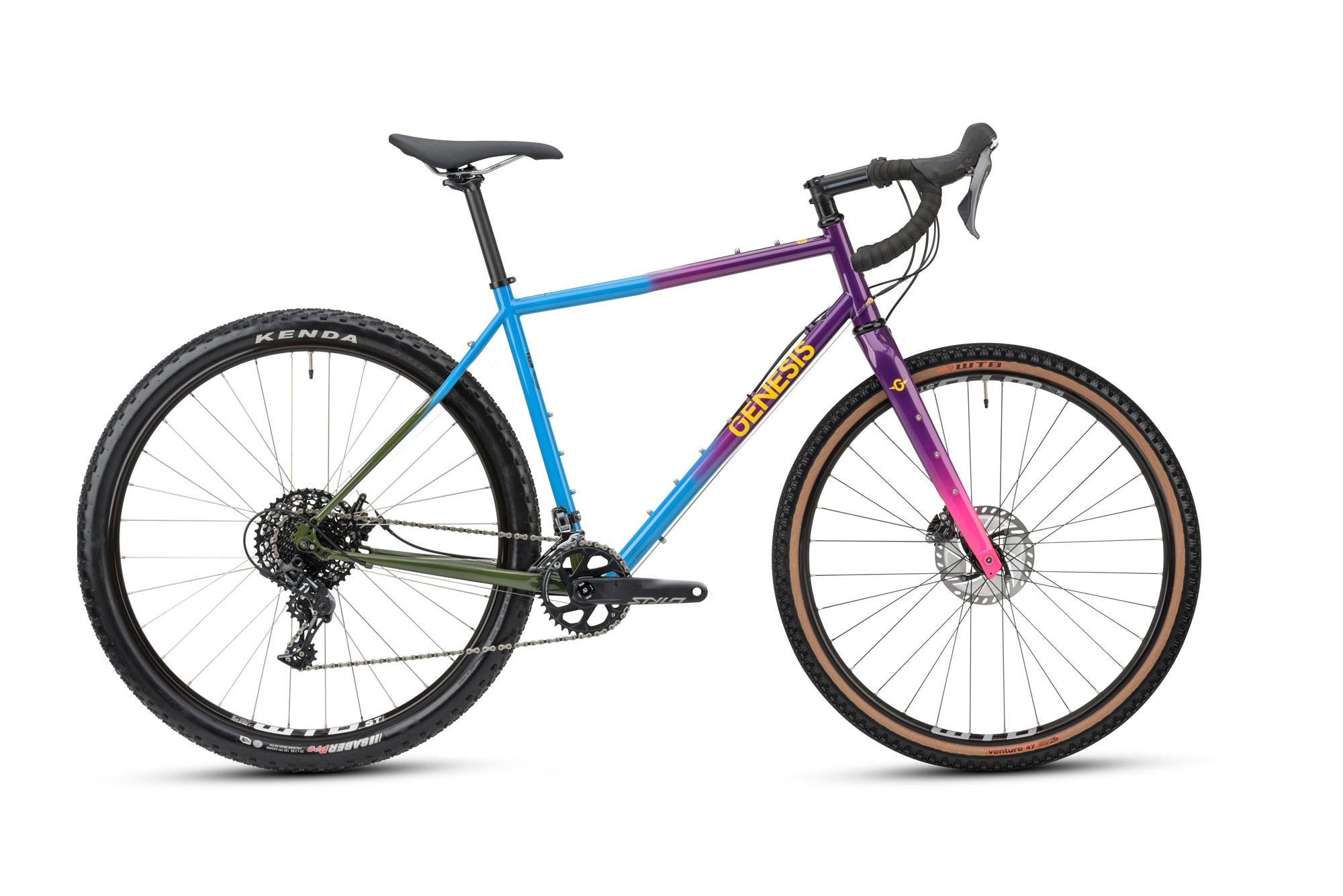
A drop bar bike that can truly do it all – it’s this concept that has inspired us here at Genesis for many years – and the reality is closer now than ever before! The arrival of quality hydraulic disc brakes for drop bars, wider gearing combinations than ever and increased tyre clearance have all influenced how we plan our rides.
However, as the breadth of what modern, drop bar bikes are capable of increases, so the gaps in-between become ever smaller. Today, getting the right bike for the terrain you’ll be taking on is a trickier question than ever.
With that in mind we thought we could run down our three most popular models, highlighting the similarities and differences and helping you make the right choice first time.
The only disclaimer? There is always justification for N+1!
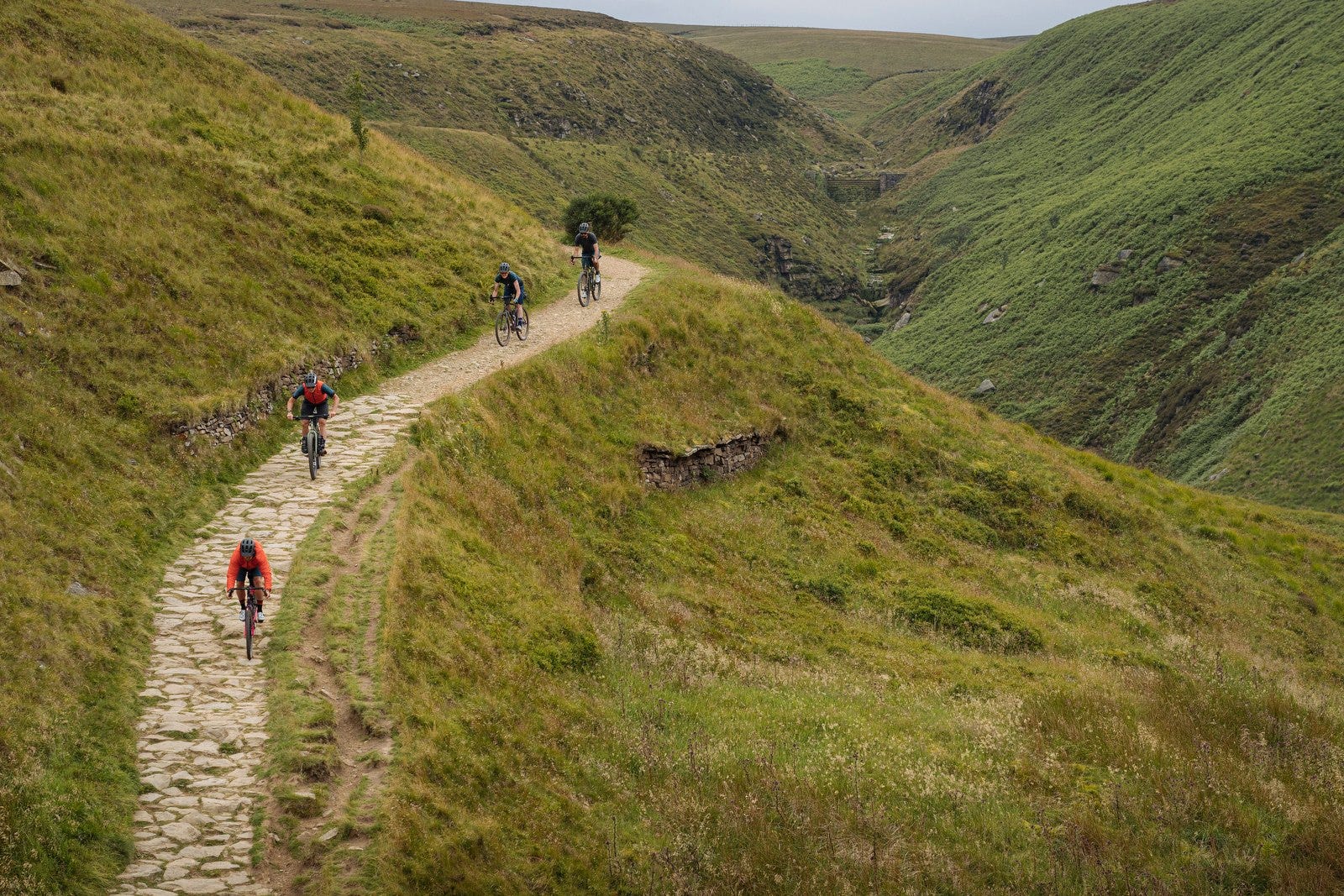
Croix de Fer and Glandon (from south), French Alps
- Epic rating
Cycling the Col de la Croix de Fer is a hard, but beautiful, ride you won’t forget. It combines steep, continually changing gradients with majestic scenery and Tour de France history. And when you ride from Bourg d’Oisans in the south, you get a little bonus of the Col du Glandon for barely any additional effort.
This is one of the big rides of the region and is not to be missed.
Looking for a return GPX route? Click here .
All metrics in this article are approximate.
Croix De Fer/Glandon highlights
The two spectacular turquoise lakes: the Lac du Verney and the Lac de Grand Maison. The latter is even more stunning than the former.
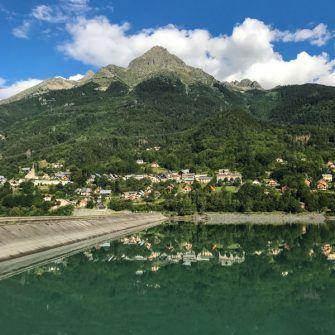
Route notes
1. bourg d’oisans to allemond: 0-11km.
It’s a straightforward, flat warm up along the main road (there’s a bike path), to the Barrage du Verney, the first dam of the day.
2. Allemond to Lac du Grand Maison: 11-30km
Once you’re around the lake, you pass the EDF hydroelectricity museum , and the climb starts to ramp up. The next six kilometres are tough, through the trees, with gradients between about 7 and 10%.
The road winds through Le Rivier d’Allemont and just the other side, there’s a fast descent down to the river. Make the most of the descent and be ready for the cruel kick up that greets you the other side.
It’s then six kilometres of changing gradients as the road winds around steep, grey cliffs. As you approach the huge wall of the Lac du Grand Maison dam, there’s a couple of nasty hairpins which take you up level with the impressive reservoir.

3. Lac du Grand Maison to Croix de Fer and Col du Glandon: 30-42 km
The Lac du Grand Maison holds 140 million cubic metres of water. It’s huge and, surrounded by mountain peaks, it’s seriously beautiful.
At the end of the lake there’s a short descent for a kilometre or so, and then you’re climbing again. The scenery changes quite dramatically here in the last section to the top. Gone are the trees and narrow, craggy valley. In its place is a wide, almost moorland vista across an open valley with green meadows and sharply jutting peaks on either side. It’s dramatic and inspiring in equal measure.
At 36.5km you pass the Chalet Col du Glandon restaurant and the turning to the Col du Glandon. From there it’s a mere three kilometres to the iron cross of the Croix de Fer summit and an additional couple of kilometres back down to the Col du Glandon.

In the village of Allemond, you’ll find a boulangerie and a few bars and cafes. Rivier d’Allemont also has some cafe options.
At the top of the Croix de Fer is a small, unpretentious cafe that serves drinks and light food (when we visited it was cash only, so come prepared!). Alternatively, you can call in at the Chalet Col du Glandon restaurant (it gets good reviews) or the little kiosk at the top of the Glandon.
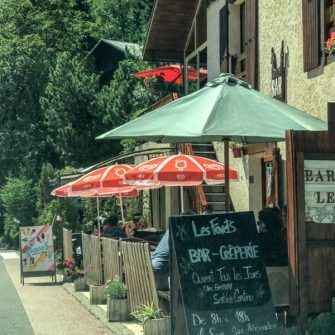
Accommodation
We’ve written a separate article on the best places to stay in/around Alpe d’Huez , based on our experiences. We hope it helps you choose!
- Don’t underestimate this ride; it’s a big day!
- Read our tips for cycling in the Alps before you set out.
- Croix de la Fer has featured in the Tour de France sixteen times since it was first used in 1947.
- In 1989 there was a 133 km sole break by Gert-Jan Theunisse which included riding Croix de la Fer alone before continuing to the top of Alpe d’Huez to take the stage and the King of the Mountain jersey.
Found this guide useful?
- We’d love to hear from you – comment below or drop us a line .
- Check out our ultimate guide to planning a holiday in this region around Alpe d’Huez and other articles on the Alps, below.
- Don’t miss our other ride guides on the area: find them all in the Road Rides section of our ultimate guide .
Please support Epic Road Rides
A huge amount of time and effort goes into the article you’ve just read, all with the aim of helping you!
If you found what you’ve read useful, I’d really appreciate it if you dropped something in the tip jar here .
It’s a way you can say thank you and help us carry on creating top quality content with no annoying ads and no pay wall.
Leave us a tip here!
Looking for an organised cycling trip?
If you want someone to help you plan and book your cycling holiday, fill out this form. We aren’t a tour operator/agent but we work with lots of people who are and will do our best to put you in touch with someone that can help (within 24 hours wherever possible)!
We will use this info to send the enquiry to Clare and/or their team. Our privacy policy explains more and here’s a reminder of our disclosure policy and terms and conditions.

Clare Dewey is a cyclist with a passion for travel. She set up epicroadrides.com in 2018 to help make it easy for cyclists to explore the world by bike. Today her mission is still inspiring cyclists to discover new places on two wheels – and doing what she can to make sure they have the best possible time while they’re there. Clare has visited 50+ destinations around the world, many of them by bike.
The contents of this website are provided for general information purposes only. It is not intended to amount to advice and you should not rely on it. You should carry out your own due diligence and take professional advice. We make no representations, warranties or guarantees, whether express or implied, that the content on our website is accurate, complete or up to date. If you use any information or content on this website, download from, or otherwise obtain content or services through our website, it is entirely at your own discretion and risk. Epic Road Rides Ltd disclaims all liability and responsibility arising from any reliance placed on the information and content on this website. Find out more here .
2 Responses to “Croix de Fer and Glandon (from south), French Alps”
Are there any toilet stops other than cafes you pointed out on the route?
Not that I’m aware of. Did you find any?
Leave your comment
Click here to cancel reply.
- Name (required)
- Mail (required) (will not be published)
This site uses Akismet to reduce spam. Learn how your comment data is processed .
Privacy Overview
- MAGAZINE OFFERS
- BIKE INSURANCE
- Best Products
- Maintenance
- Accessories
- Long-Term Reviews
- BikeRadar Podcast
- First Look Friday
- Bike of the Week
- Tech Features
- Routes and Rides
- Bike Galleries
- BikeRadar Bargains
- Buyer's Guides
- Fitness & Training
- Sizing & Fit
- Mountain Biking UK
- Cycling Plus
BikeRadar Builds | Matthew’s Genesis Croix de Fer 853
Matthew’s Shimano GRX testbed is all steel all the time
Matthew Loveridge / Immediate Media
Matthew Loveridge
This week’s BikeRadar Build is my Genesis Croix de Fer 853 with GRX – Shimano’s dedicated gravel and adventure groupset.
The Croix de Fer is a bit of an institution, an unapologetically weighty steel tourer that was a gravel bike before gravel became the achingly trendy riding niche it is today.
Genesis offers the CdF (as it’s widely known) in various grades of steel, and there’s a titanium option too.
The Reynolds 853 variant is the poshest of the ferrous options, and it’s sold as a frameset only, complete with an all-steel fork.
- Genesis launches carbon fork for stalwart Croix de Fer
- Matthew's custom Trek Emonda ALR eTap long-term review
- Why virtual bike racing utterly fails as a spectator sport
I was looking to build a bike based on a mid-range Shimano GRX gravel groupset and the CdF ticked the boxes because it takes the latest flat-mount brakes and has 12mm thru-axles front and rear, so I knew there wouldn’t be any compatibility issues.
At the same time, it’s a very straightforward frame with fully external cable routing and a proper threaded bottom bracket.
The bike is meant for 700c wheels but, as we’ll get to, 650bs will fit, sort of. I’m keen to use this bike as a do-everything machine for on-road cruising, gravel and perhaps winter riding with full mudguards too.
Welcome to BikeRadar Builds
BikeRadar Builds is our occasional look at the team’s personal bikes, including custom rigs, commuters, dream builds, component testbeds and more.
This is our chance to geek out about the bikes we’re riding day-to-day, and explore the thinking (or lack of it!) behind our equipment choices.
Croix de Fer 853: heavy metal
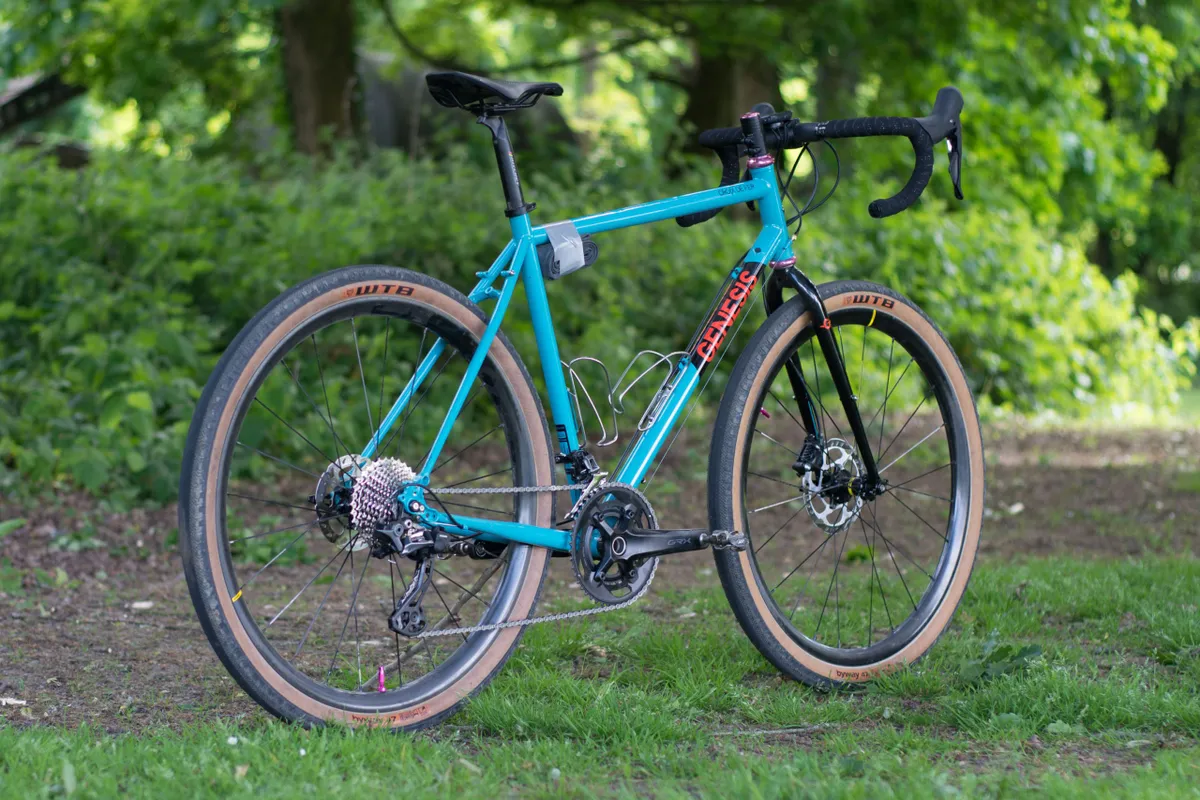
There is no such thing as a weight weenie Croix de Fer. My medium frame (385mm reach, 593mm stack) weighs 2.4kg, but perhaps more startling is the 1.3kg of fork (uncut) that accompanies it.
That’s more than a decent aluminium road frame in its own right, and a good kilo over a high-end carbon road fork.
I say this not as a criticism of the bike, but to put things in context.
The idea with this build was to assemble the combination of Shimano GRX components that I think will be most popular among those building their own bikes, i.e. the cheapest 11-speed mechanical setup.
GRX doesn’t offer components at every level in the groupset hierarchy , so that means Ultegra-level RX810 front and rear derailleurs, 105 level RX600 shifters and RX400 Tiagra-level brakes.
I wanted a wide range of gears without huge jumps, so I opted for a 2× setup with Shimano’s RX600 46/30t crank.
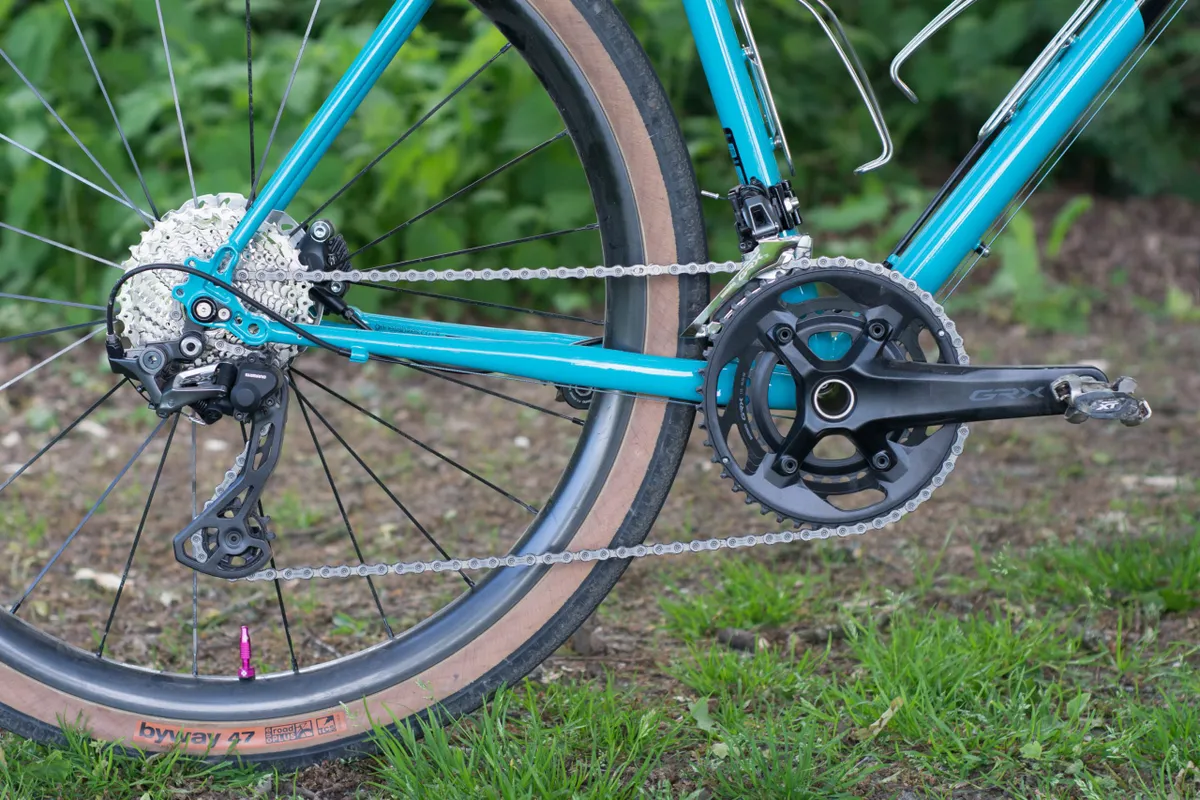
Combined with an 11-34t cassette, this gives a seriously low bottom end (even with chunky tyres) without sacrificing too much at the top for my purposes.
I’ll be writing a separate review of the groupset, but building the Croix de Fer was a good refresher because Shimano’s groupsets have evolved considerably since I was last regularly building bikes up from a pile of boxes.
The correct cable routing for the front derailleur isn’t particularly intuitive, for instance, so I found Shimano’s extensive tech docs invaluable.
Another small detail that caught me out was the flat-mount rear caliper mounting bolts. As these thread directly into the caliper body when you're using a 140mm rear rotor, with a retaining pin for added security, the bolts need to be exactly the right length, and of course I had the wrong ones on hand.
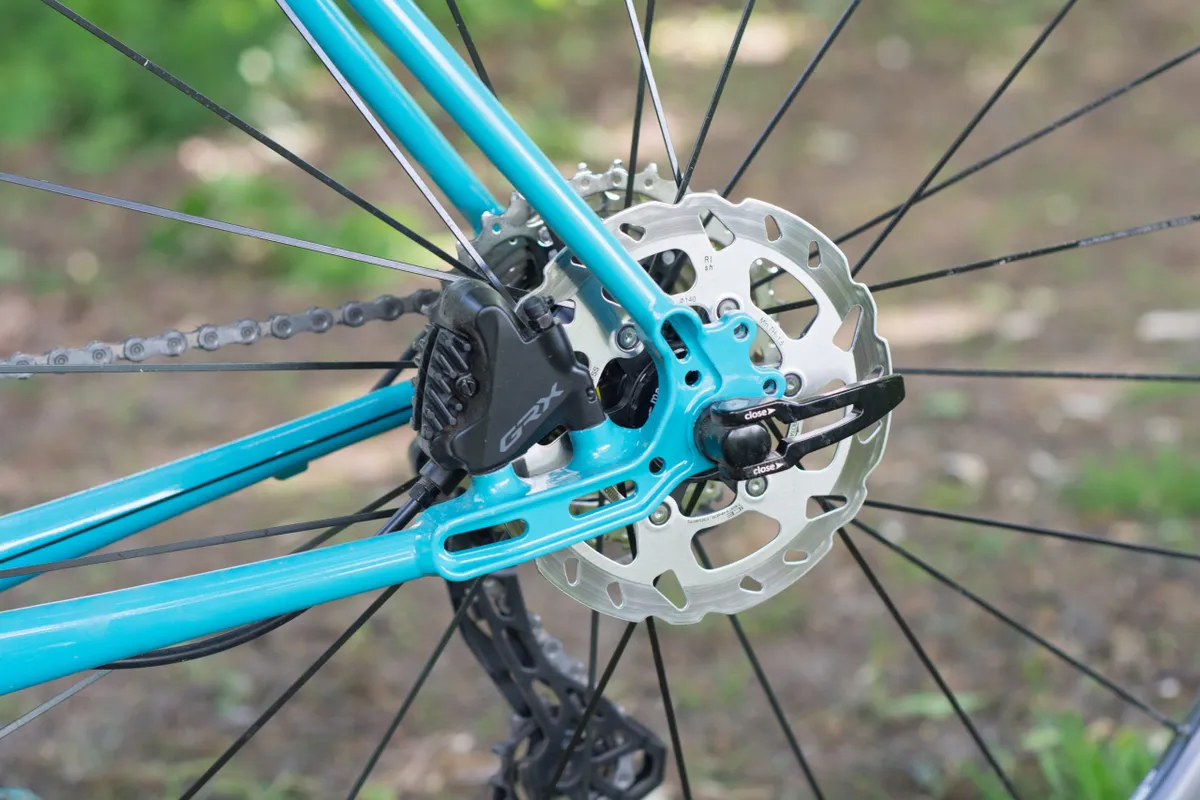
A shout out goes to Mike at Madison for quickly sending me a box containing pretty much every bolt size, ensuring I ended up with the right ones.
Leftovers. Delicious, expensive leftovers
The rest of the build is mostly stuff I had lying around. The seatpost and saddle are from my now sadly departed Trek Emonda ALR while the bars and stem are random leftovers I had kicking around my garage.
Most delightful of all is the pink Chris King headset, which I’ve been hoarding for years.
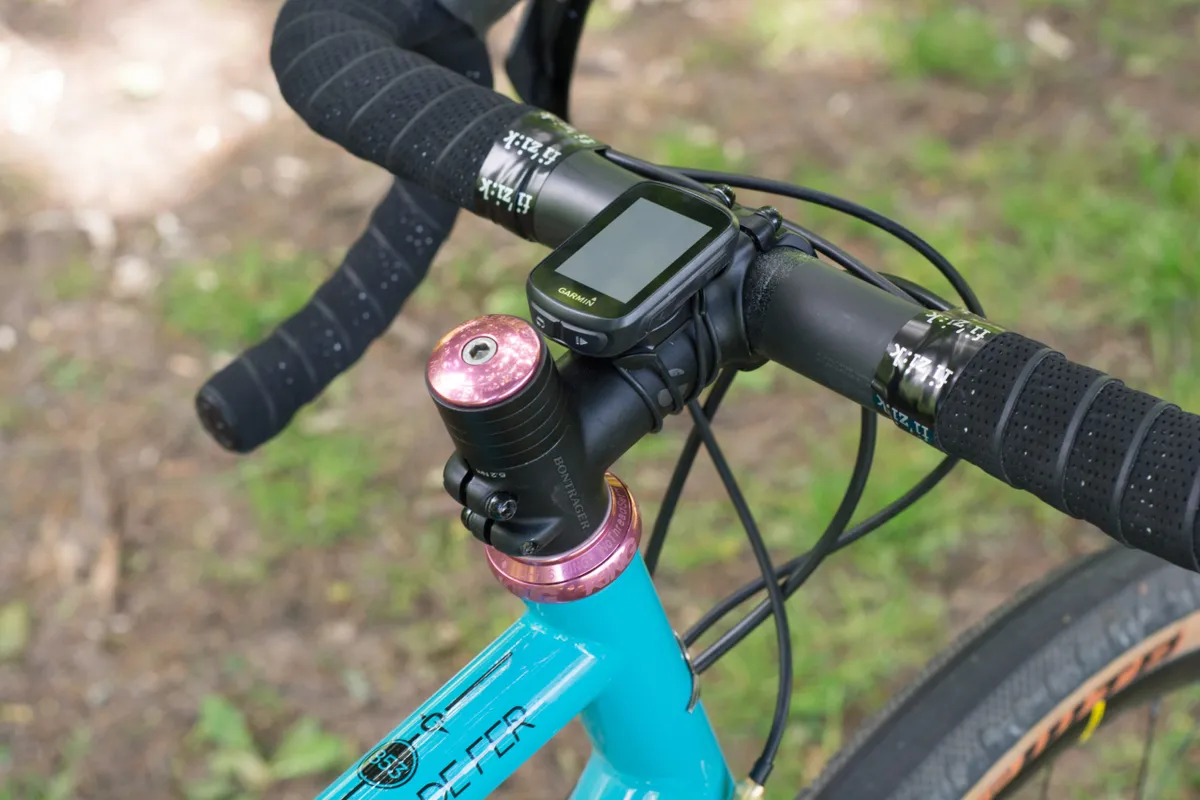
The Croix de Fer has a now-rare old-school 1 1/8in straight steerer, so I finally had an opportunity to use this gorgeous headset, a much more exciting object than the no-name item that comes with the frameset (although I’m sure that would have been absolutely fine).
Oh and the nice people at Temple Cycles sent me some rather elegant stainless steel bottle cages , while the bar tape is cushy Fizik stuff.
(Side note: either I’ve lost my touch or it’s near-enough impossible to wrap Shimano hydraulic levers with no gaps without using the cheater strips. I am filled with shame.)
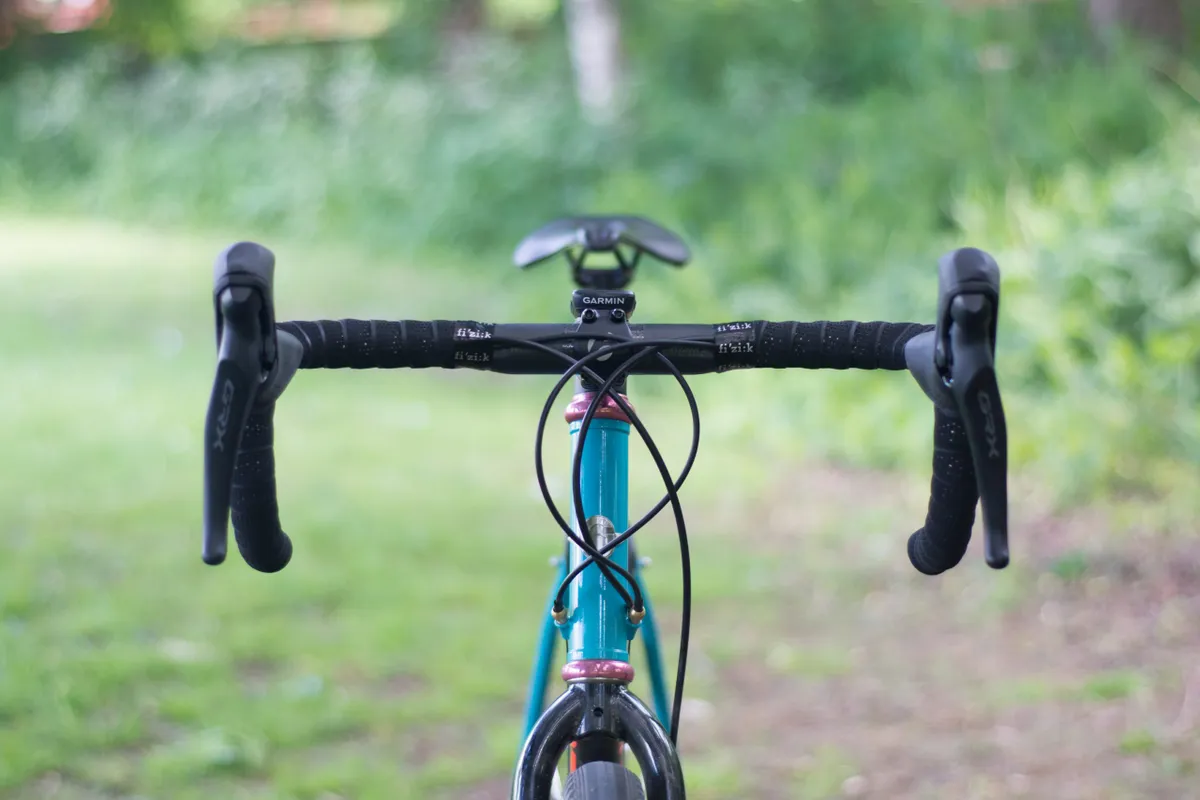
Then there are the wheels, which might seem a little out of keeping with the rest of the build because they’re the fearsomely expensive Mavic Allroad SL .
These are 650b and have hookless carbon rims that measure a very respectable 26mm internally.
I should note that the Croix de Fer is not actually designed for 650b wheels and its official maximum tyre size is a 700c × 38mm.
With 650b × 47mm WTB Byway tyres there’s lots of clearance everywhere except the chainstays, where the rear tyre’s moulding whiskers are skimming the frame.
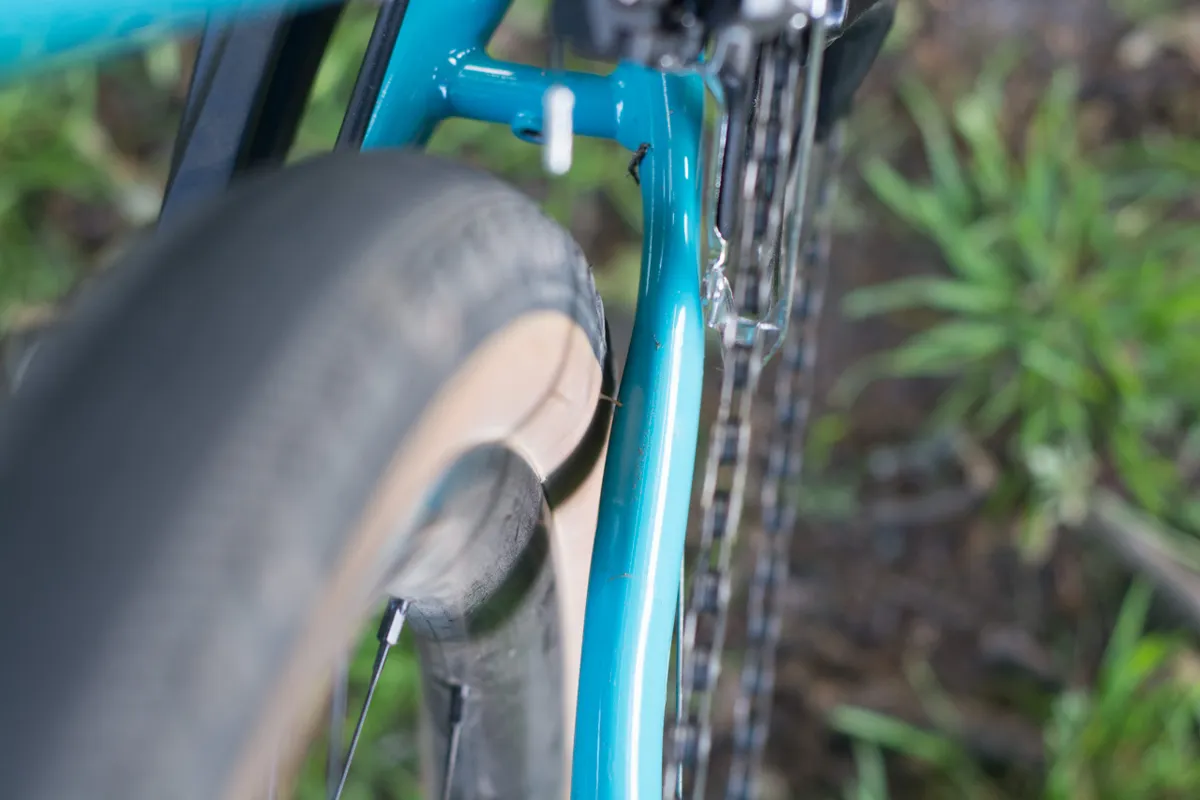
Is this a good idea? Probably not. However, I’ve already decided that these tyres are simply too fat for the riding I’m doing anyway.
They have a pleasing balloon-like quality to them, but at low pressures they feel a little too draggy on tarmac for my liking, so I’m going to try something skinnier and likely experiment with 700c wheels too.
I need to do something to the tyres in any case because I somehow failed to align the front’s logo with the valve stem, a grave offence in some quarters.
I mentioned weight earlier, and it goes without saying that this isn’t a light bike. However, thanks to some very expensive bits and bobs, the total figure is 10.8kg without pedals, which really isn’t too shabby for a bike like this.
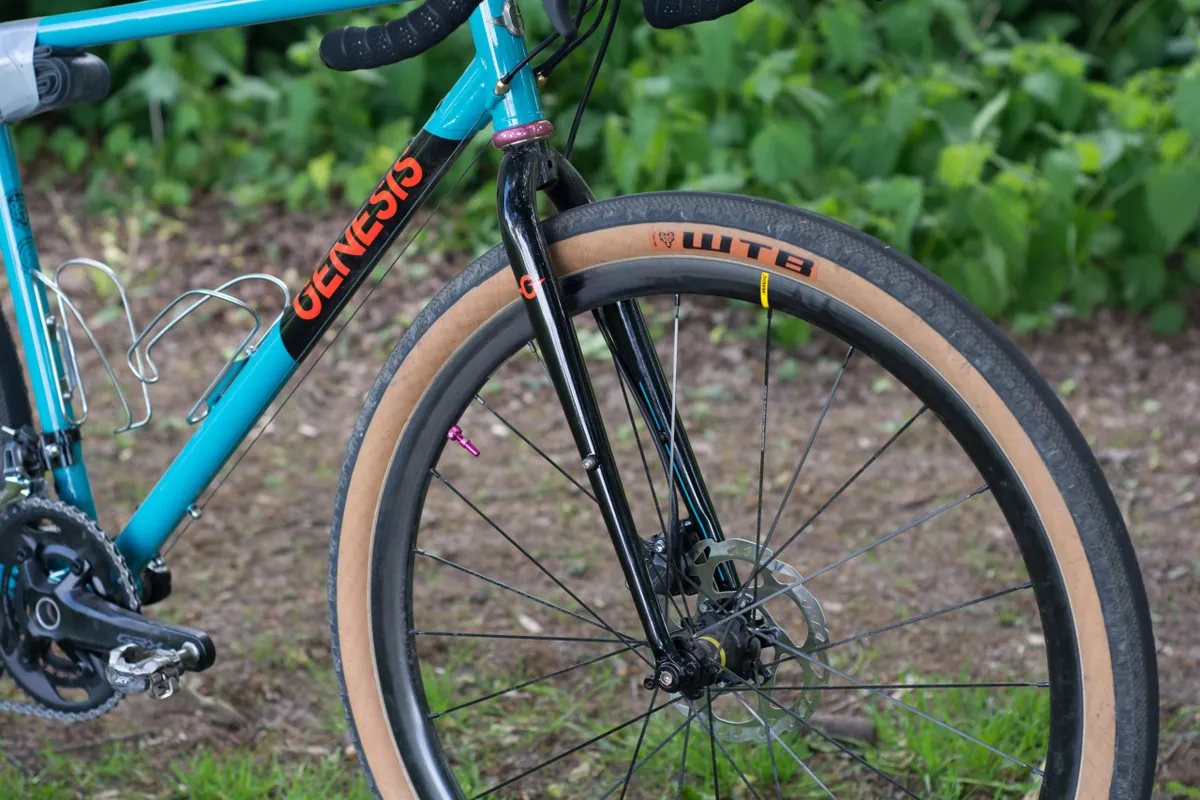
Genesis does offer a carbon fork for the Croix de Fer which might be a worthwhile upgrade down the line, but there’s something quite appealing about an all-metal machine.
The bouncy elephant in the room
I have a confession: I haven’t ridden the Croix de Fer a great deal yet and it’s not because of the coronavirus lockdown, it’s the fault of my long-termer, the stunningly good Specialized Roubaix Expert .
The problem is that the carbon über-machine is a little bit too good at everything and despite being a road bike, it’s pretty good at faking it as a gravel machine, at least in the dry, so I keep riding it instead of any of my other bikes.
I will be giving the sturdy Croix de Fer the chance to prove itself properly though, and I look forward to putting even more stupidly expensive and inappropriate componentry on it.
What would you like to know about this machine?
Genesis Croix de Fer 853 GRX custom build spec
- Frameset: Croix de Fer Reynolds 853 steel
- Fork: Cr-Mo steel with 12mm thru-axle
- Groupset: Shimano GRX RX600 levers, RX810 derailleurs, 46/30t RX600 cranks, 11-34t cassette
- Brakes: Shimano GRX BR-RX400 disc
- Wheels: Mavic Allroad SL+
- Tyres: WTB Byway 650b × 47mm
- Cockpit: S-Works carbon 42cm, Bontrager 90mm stem, Fizik bar tape
- Seatpost: WCS Link Carbon FlexLogic seatpost 27.2 × 350mm
- Saddle: Specialized Power
- Pedals: Shimano Deore XT M8000 SPD
- Accessories: Temple Cycles stainless steel cages, Garmin Edge 130, inner tube w/duct tape, Muc-Off tubeless valves
- Price: £899.99 (frameset only)
Share this article

Contributor

- Terms & Conditions
- Subscribe to our magazines
- Manage preferences

Based on frame geometry and build specs.
A bike with lower gearing will be easier to ride up steep hills, while a higher top end means it will pedal faster down hills.
(descending)
Based on build material and quality level of the frame, fork, wheelset, groupset, suspension system, and more.

IMAGES
COMMENTS
The bar and stem of a drop bar bike mean you less "reach" than a flat bar bike for the same riding postion. There are very few of these rigid bikes with low gears like the TDF. Most hybrids ...
Cycle magazine editor Dan Joyce tests a Genesis Tour de Fer 30 and Bombtrack Arise Tour. ... The UK-designed Genesis Tour de Fer 30 - the name is a spin off from the brand's popular Croix de Fer - is the top model of four, two of which have drop bars, two flats. The flat-bar bikes are £250-£350 cheaper and come with more practical ...
Tires. Kenda Booster 700 x 40c Tubeless Ready. Schwalbe Marathon. Bontrager H1 Hard-case Ultimate, 700x38c w/reflective sidewall. The Genesis Croix De Fer 20, Genesis Tour De Fer 20, and Trek 520 are all steel frame road bikes. The Tour De Fer 20 has better components, while the 520 has an aluminum fork.
7. 9. The Genesis Croix de Fer 20 is a go-anywhere bike, based around a smooth-riding steel frameset with large tyre clearances and a huge array of mounting points for accessories to aid your commuting or adventure rides.
Similarly, while there is functionally nothing wrong with the Sora 9-speed drivetrain on the CdF, the Tiagra 10-speed specced on the Croix De Fer is a joy to use. While cassettes are easy to swap out, I appreciated the much more practical 11-28 the Croix de Fer comes with, compared to the 11-25 on the (heavier) CdF.
The Croix de Fer 20 has a 50/34 compact chainset, coupled to an 11-34 cassette. This gives a huge range, allowing you to progress at reasonable speed on the road and also to tackle steep and muddy ...
Looks aside, though, the Croix de Fer is a pretty exciting prospect to get out onto the road — and off it. The Reynolds 725 frame and fork soaked up the bumps of tarmac and trail beautifully.
Genesis Croix de Fer 10 Flat Bar first ride review - BikeRadar
De Genesis Tour de Fer 30 is een veelzijdige en comfortabele toerfiets die geschikt is voor lange afstanden, zware bepakkingen en uitdagende terreinen. Lees onze review om te ontdekken waarom we ...
TOUR DE FER 20 & 30: HIGHLIGHTS (at least some of them) in our opinion. - 725 REYNOLDS STEEL: it is a classic seamless crmo but heat-treated boosting tensile strength so that thinner walls can be used, achieving a lighter frame weight without compromising strength. Heated to around 1600F, the steels' crystal lattice gets a more uniform and ...
Tour de Fer 10 is just as suited as a daily commuter as it is a cross-continent tourer.' Where does this model sit in the range? Tell us briefly about the cheaper options and the more expensive options . This is the entry-level model. The more expensive models come similarly equipped, though with higher-end gears and dynamo lighting. ...
The basic geometry of the Croix/Tour De Fer frame is superb, long standing and versatile but neither of these offers it in a particularly high quality steel, so weight will be high, especially for the TdF10 which I think must be a lower quality steel than the Reynolds 725 used for the TdF20. I'd describe the components on both bikes as ...
British-designed steel go-anywhere, do-anything machine
I have a 2014 Croix de fer and I love it. It really is great for lots of types of riding. I commute with it, go on long day rides in the hills (big hills in the lake district in UK), and of course touring. Fitted a rack and mud guards and put a 32 cassette on the back. It's a very comfortable and quick bike! Can't speak for the other one though ...
Legendary Member. One direct alternative to the CDF 30 is a Kona Sutra LTD. Like the CDF it has a steel frame with a standard external BB. It uses the normal touring Sutra's steel frame, so it's a really comfy road bike, but is fitted out for off road riding with a SRAM 1 x groupset and hydraulic brakes.
Genesis Croix de Fer Ti review. The Croix de Fer range has a new ruler - this adventure bike has everything we love of the steel-framed version, in a better-looking and faster package. Buy if, You ride mixed terrain, fast, and are willing to spend extra on titanium.
The Col de la Croix de Fer (2,067 meters) connects the Isère and Savoie regions. The area - on both sides - attracts many cyclists, as there are many famous climbs to be found, besides this one. In Isère - centred around Bourg-d'Oisans - these include the Lautaret, Les Deux Alps, la Bérarde and "the most famous of them all ...
The Genesis Tour De Fer 10, Genesis Croix De Fer 20, and Kona Sutra SE are all steel frame road bikes with mechanical disc brakes. The Sutra SE has better components.
The geometry of the Croix de Fer is finely balanced. Although it has a very similar stack and reach to our Fugio, the top tube is 6mm shorter. The headtube is 10mm shorter and a degree steeper which combines to give a more aggressive position on the bike. Perhaps most importantly, the Croix de Fer has an 8mm lower bottom bracket drop.
Croix de la Fer has featured in the Tour de France sixteen times since it was first used in 1947. In 1989 there was a 133 km sole break by Gert-Jan Theunisse which included riding Croix de la Fer alone before continuing to the top of Alpe d'Huez to take the stage and the King of the Mountain jersey.
Matthew's Shimano GRX testbed is all steel all the time and weighs nearly 11kg.
Only show differences. Tour De Fer 30 2021 Genesis. Sutra SE 2022 Kona. Croix De Fer 20 2022 Genesis. RRP. £2,099. (£1,421) £1,699. Where to Buy.
Match no 1: Samedi, 17 h HE au PNC Arena (MAX, truTV, TBS, SNP, SNW, SNE, SN360, TVAS) Les Hurricanes de la Caroline et les Islanders de New York ont à nouveau rendez-vous en première ronde des ...
The Genesis Cda 30, Genesis Croix De Fer 20, and Origine Trail T26 are all gravel bikes with mid-range components. The Croix De Fer 20 has a steel frame, while the Trail T26 has a carbon fork and 650b aluminum wheels. Similar Bikes. Accessories. Ride Feel. Based on frame geometry and build specs. Rider Position. relaxed aggressive.